





It’s we what







It’s we what
t’s the end of the year. If you missed my thoughts on the impossible task of credibly naming an adventure bike of the year, please have a look at issue #19.
mentions or hedging of bets with classes or sections
v Chosen from the bikes I’ve ridden this year. There’s lots of great bikes I didn’t ride in 2017
v It’s a personal opinion.
The bike which impressed me most in 2017?
“It belted out into the desert in the hands of a not-very-confident rider and demolished the sand and dunes. ” Tom Foster - Editor
Still, I do get to sample some exceptional bikes, and I’ve always enjoyed a challenge, so I’ll stick out my jaw and name one new bike I’ve ridden this year I believe was exceptional.
Remember the criteria I set in 2016: v Name one bike only. No honourable
The Husqvarna 701 Enduro.
I asked more of the Husky than any other bike I rode in 2017, so it’s fair to say it had an opportunity to excel that other review bikes just weren’t offered – I’m talking about the Simpson ride featured in issue #25. That’s undeniable.
But that being the case, the Husky devoured the long bitumen distances and never once seemed to be working hard. Without a single change or adjustment it belted out into the desert in the hands of a not-very-confident rider and demolished the sand and dunes. It was as though the bike wasn’t even trying. Power delivery was exceptionally smooth and manageable and brakes and handling were beautiful.
On a less obvious level, as I prepped the bike for that ride, I was continually surprised and impressed with the build quality and excellent components on the bike.
So there it is.
My choice for most impressive bike I rode in 2017 is the Husqvarna 701 Enduro. Thanks Husqvarna Australia for the opportunity to experience such an exceptional motorcycle.
I can only imagine what the 2018 models will offer, and I can’t wait to find out.


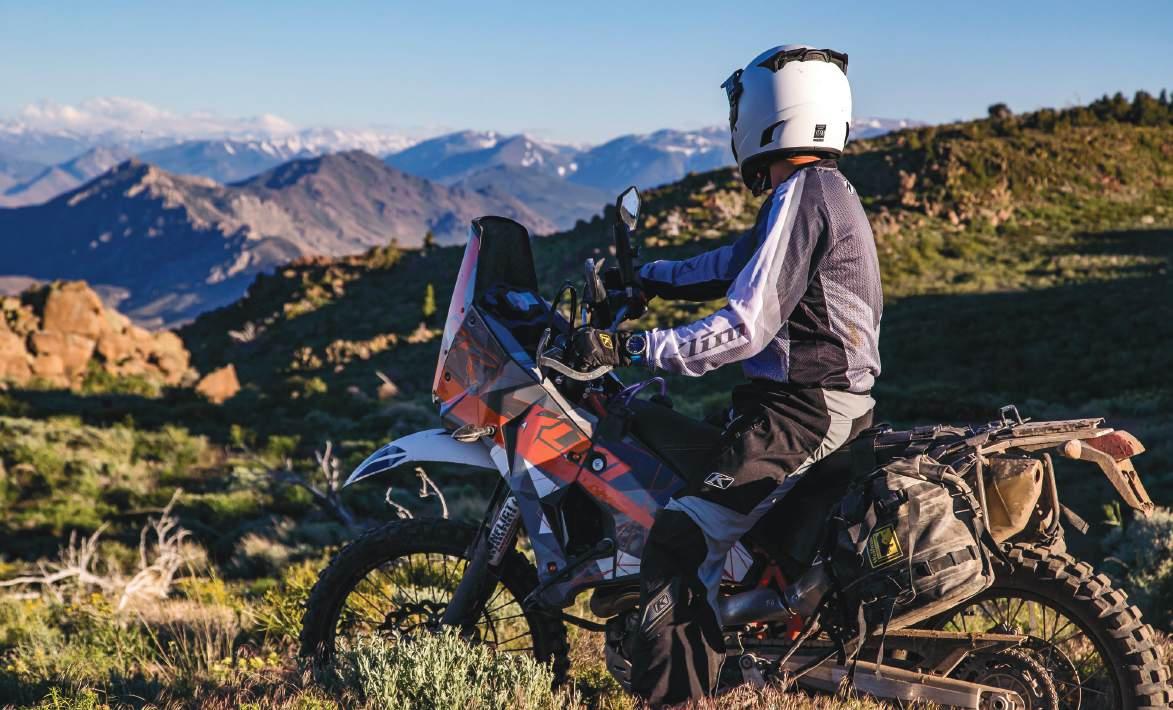



The Klim F5 Helmet combines extremely low weight, intuitive venting, and nextgen safety features, KLIM has engineered the F5 to provide the best possible riding experience in the most demanding Australian environments.
The Klim Krios ADV helmet with transition lens weighs only 1500 grams while offering superior strength, performance and functionality.

The KLIM Dakar Jersey and pant is the perfect highly durable balanced-ventilation off-road jersey. Designed specifically for aggressive riders who demand high versatility and toughness from their off-road gear. Engineered to give riders the ability to remain comfortable in a wide range of conditions and temperatures all-day. The Dakar Pant available in two different styles “In The Boot” and “Over The Boot”.

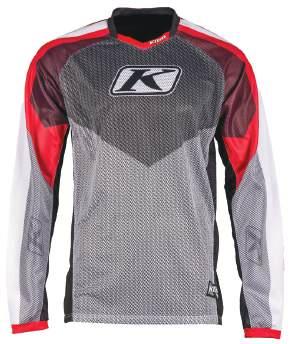
The KLIM Mojave Jersey is a fully-ventilated off-road jersey designed specifically for aggressive riders in the hottest environments across the Australia. Made from a strategically constructed mesh chassis the Mojave offers all-day comfort, incredible ventilation and epic durability. The Mojave Pant available in two different styles “In The Boot” and “Over The Boot”.





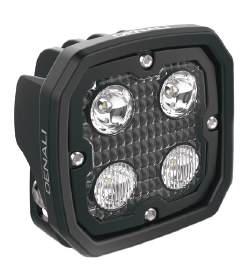
D4 2.0 Light Pod with DataDim Technology
The DENALI D4 2.0 LED light pod with DataDim technology was engineered from the ground up to create the brightest, most efficient

Plug-n-Play Controller for BMW R1200 LC-Series
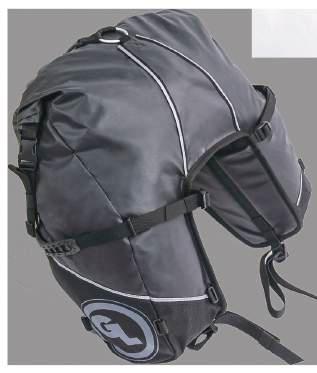
Great Basin Saddlebag Roll Top


Features a convenient rolling closure that seals out water and dust while maintaining all the unique “go light, go fast, go far” features of our zipper closure Great Basin Saddlebag.

Harness the flexibility and intelligence of your BMW motorcycle’s CANbus electrical system to make installation of accessories drastically easier with the DENALI CANsmart™ Controller.

Monday-Friday 9.00am - 5.15pm Saturday 10.00am - 4.00pm
MotoTrekk Panniers
A rugged, stable, universally fitting, affordable, waterproof, rack-mounted motorcycle soft luggage solution for virtually all motorcycle makes and models. Suitable for our new Africa Twin Pannier Frames.
Skid Plate KTM 1090 Adventure

Protect your engine with this tough skid plate made from 5mm thick laser cut aluminium incorporating our uniquely designed venting system.



While preserving the low centre of gravity feature of the KTM 1090 Adventure these upper crash bars are lightweight but retain their superior strength by incorporating our non-floating design.
EARN REWARDS & FREE SHIPPING ON THESE PRODUCTS WITH COUPON*: ADVRIDER26
OFFER EXPIRES: 5TH OF FEBRUARY 2018


Adventure Rider Magazine is published bi-monthly by Mayne Media Pty Ltd
Publisher Kurt Quambusch
Editor
Tom Foster tom@maynemedia.com.au
Group Sales Manager
Mitch Newell
mitch@maynemedia.com.au
Phone: (02) 9452 4517
Mobile: 0402 202 870
Production
Arianna Lucini arianna@maynemedia.com.au
Design
Danny Bourke art@maynemedia.com.au
Subscriptions (02) 9452 4517
Accounts
Jeewan Gnawali jeewan@maynemedia.com.au
ISSN 2201-1218
ACN 130 678 812
ABN 27 130 678 812
Postal address: PO Box 489, DEE WHY NSW 2099 Australia
Website: www.advridermag.com.au
Enquiries:
Phone: (02) 9452 4517
Int.ph: +61 2 9452 4517 Int.fax: +61 2 9452 5319

8 advridermag.com.au






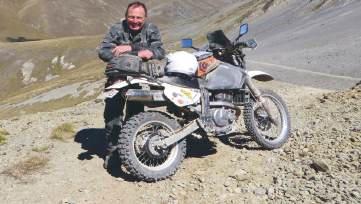

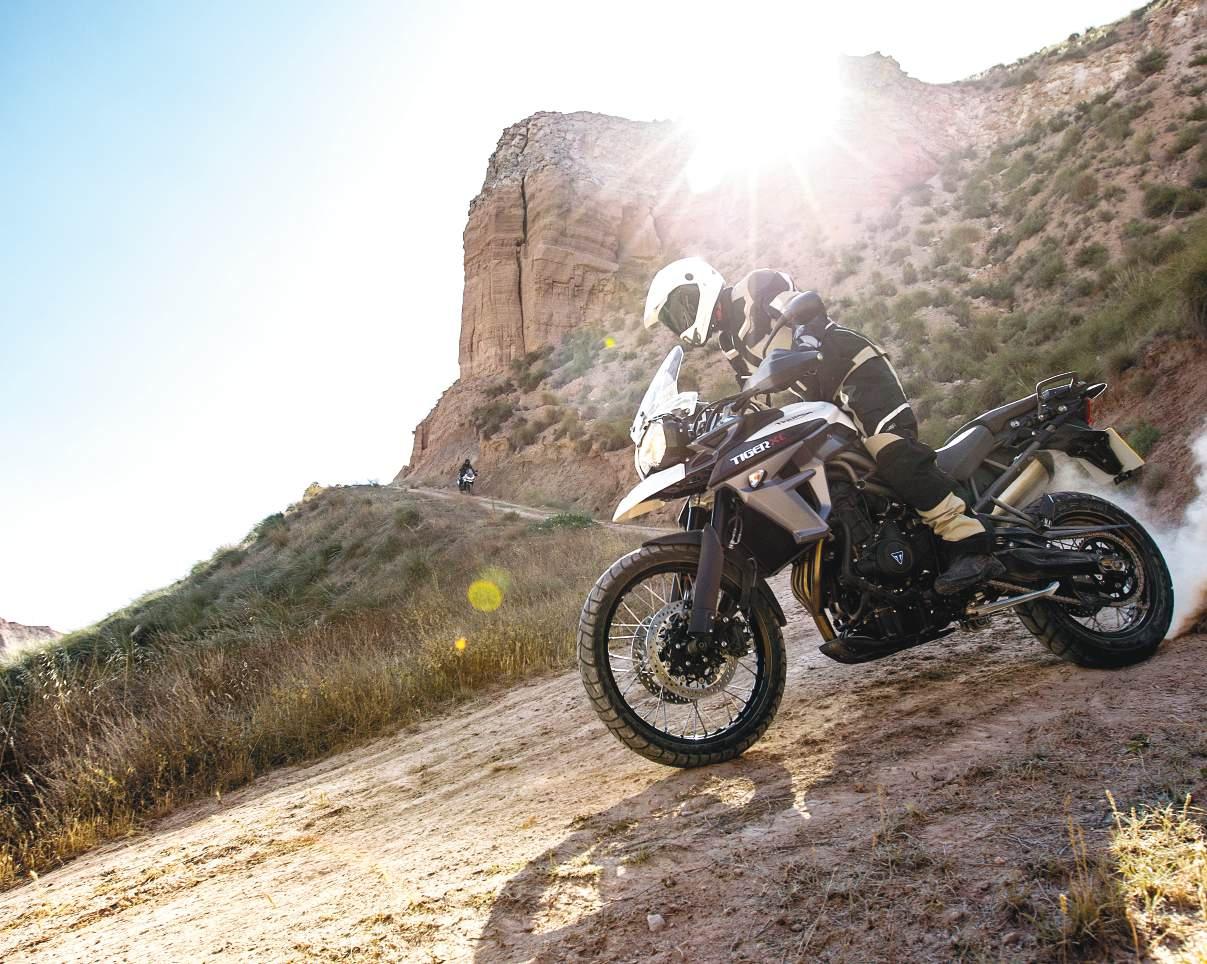









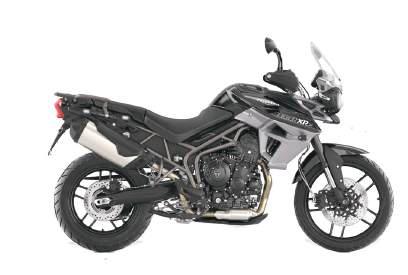


Riding across Australia and back again is no mean feat. When the bike of choice is a 300cc, multi-cylinder newbie even Kawasaki says wasn’t made for the job, it’s really testing the limits of both rider and machine. Robin Box and Mick Hamilton set off on a wide loop which would take them from Victoria to Byron Bay, west to the far coast, south through places like Perth and Esperance, across the Nullarbor and back to Victoria. There was some trepidation at the start but they arrived home with big grins and full of praise for the Kawasaki’s Versys-X300.

Since the adventure-bike phenomenon began, a smalldisplacement, multi-cylinder bike has been the missing stepping stone for many riders not comfortable on bigger bikes, especially those who are a little ‘height-challenged’.
The unproven Kawasaki Versys-X300 was chosen for this across-Australia journey and was seen as exceptional value, coming in at under $6500, but with enough horsepower to run along at a decent speed on a long-haul trip.
Originally three riders had put their hands up, but a few days before setting off, business commitments meant one
couldn’t make the start, leaving Touratech Australia and Safari Tanks boss Robin Box to complete the ride with good mate Mick Hamilton.
Mick is an experienced adventure rider, a mechanic by trade and runs his own heavy machinery business. He’s also a fixed-wing and helicopter pilot, making him extremely methodical in his planning and calm in his decision making – vital traits on an outback ride.
And this was no ordinary ride, with a distance of 10,800km on a trek through some of Australia’s best-known outback adventure destinations including Tenterfield, Bourke, Tibooburra, Cameron Corner, Oodnadatta, Finke, Alice Springs, Mount Magnet, Norseman, Port Augusta
Left: The Great Ocean Road on a good day is hard to beat.
and Seymour before finishing back in Carboor in north-east Victoria.
The choice of the Kawasaki Versys-X300 was an interesting one, but never once did the team regret the decision.
The bikes managed big distances quite comfortably, all while revving hard. The multi-cylinder 300s redline at 12,000rpm, but anything under 10,000rpm didn’t stress the durability of the bike. Riding at around 7000rpm had the bikes travelling at around 100kph to 110kph.
The 300cc bikes don’t have a hightorque motor, so it’s never going to be a rapid overtaking bike. However, the ability to push into a headwind – even when riding at 120kph – was impressive. It did increase fuel consumption, though. Normally economy was around 22km per litre at 110km/h, but that increased to around 16km and 17km per litre when battling straight into a breeze. The bikes would still easily do the speeds asked for, but they used more fuel.
“In my opinion, the Kawasaki’s ability to push into a headwind was even better than what the old Honda 600s could do,” said Robin. “The torque delivery is a lot kinder to tyres too.
Tyre life was way better than we’ve ever experienced before.
“We did the whole trip on one set of

As always, our mudmap only gives an approximation of the actual route. Robin is keen for people to understand riding across Australia doesn’t necessarily mean battling The Simpson and some of the tougher options. For those who might be contemplating the ride, grab a map and connect up the following main towns to follow Robin and Mick’s track: Carboor (Victoria), Byron Bay, Tenterfield, Goondiwindi, Bourke,Tibooburra, Cameron Corner, The Strzelecki Track to Lyndhurst, The Oodnadatta Track to William Creek and Oodnadatta, Dalhousie Springs, Mount Dare, Finke, Alice Springs, through the West MacDonell Ranges including Ormiston Gorge and St Helen’s Gorge, Mereenie Loop, King’s Canyon, The Great Central Road, The Giles Weather Station, Warburton, Tjukayirla, Laverton, Leonora, Leinster, Sandstone, Mount Magnet, Geraldton, Perth, Bunbury, Albany, Esperance, Norseman, cross the Nullabor Plain, Head of Bight, Port Augusta, Warrnambool, The Great Ocean Road, Geelong, Seymour, Carboor.
12 advridermag.com.au
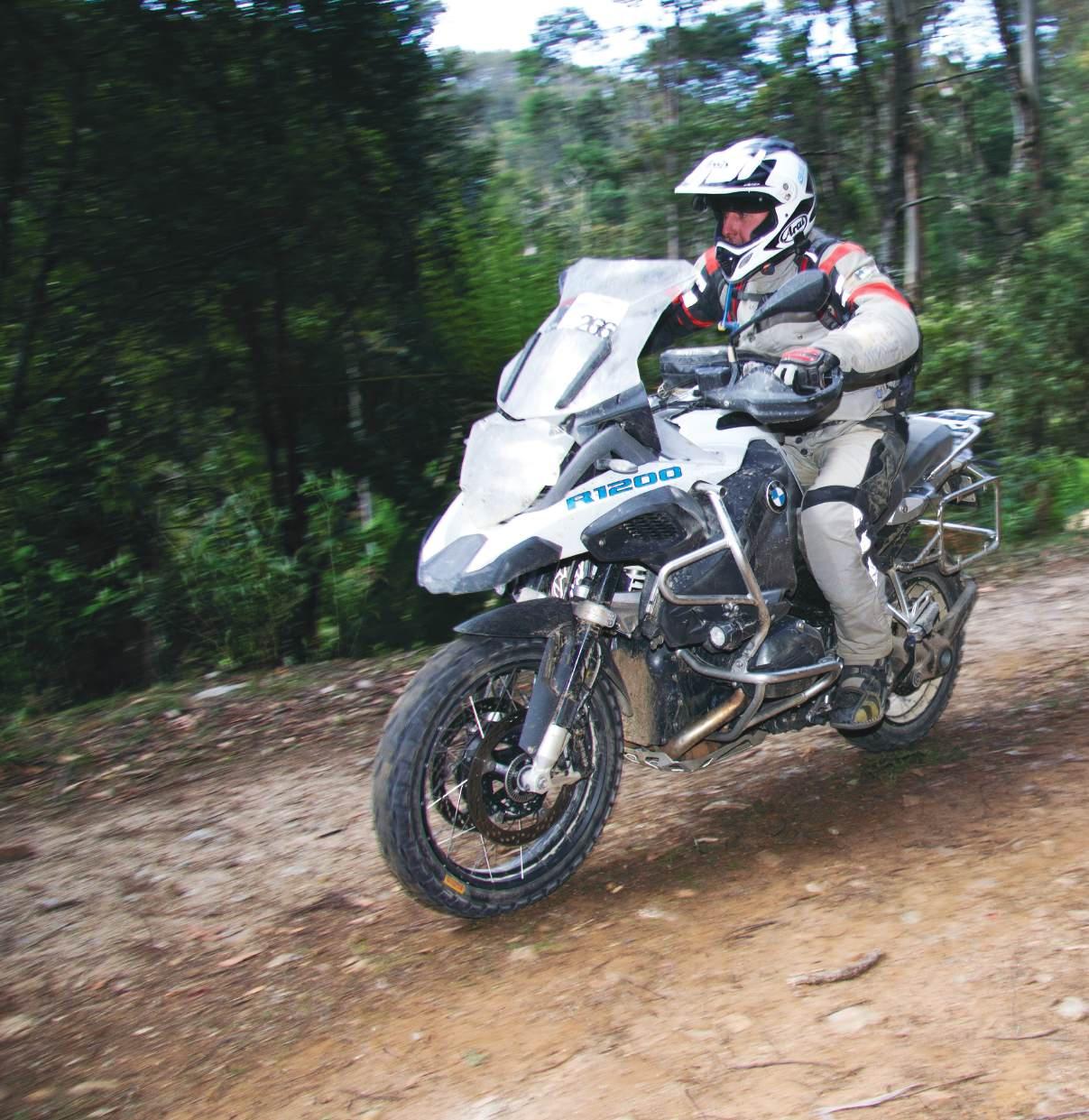



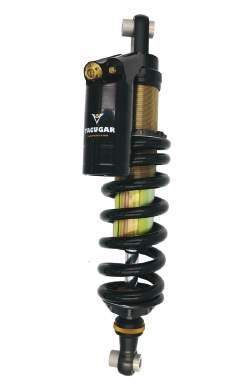
VARIOUS LEVELS OF ADJUSTABILITY
CHOICE OF LINEAR OR PROGRESSIVE SPRING
OPTIONAL LENGTH ADJUSTER +/- 2,5MM (BOTH FRONT AND REAR)
OPTIONAL HYDRAULIC PRELOAD ADJUSTER (REAR ONLY)
5 YEAR WARRANTY
100% SERVICEABLE
DESIGNED, ENGINEERED & ASSEMBLED IN THE NETHERLANDS TO ENSURE A HIGH QUALITY SUSPENSION PRODUCT.

tyres. We probably should’ve replaced them after 6500km, but they did another 4000km.
“They were pretty much completely worn out by the time we got home, but they lasted well.”
Getting set up
Kawasaki suggested the Versys-X300 was never intended as a hard-core adventure bike, and the bike was only designed to handle light conditions. Robin and Mick were mindful of this and took special care in preparing the bikes for the tough run they expected.
The Versys-X has no frame rails under the engine and the exhaust is also quite exposed, so a bashplate was manufactured to protect the frontmounted oil filter. A bigger foot was fitted to the sidestand, as any standard foot will just sink in to sandy surfaces.
Because both riders were around 180cm-183cm tall, the bikes were too low and foam fillers raised the seat heights by
50mm to make the riding position more comfortable.
Barkbusters VPS with special spoilers were fitted, and one of the bikes used the anti-vibration weights. These were found to be a real advantage on such a long and arduous ride. Heated handgrips were also slipped on for the cold weather and were used for most of the ride.
The bikes sported Kawasaki crash bars which had room to mount auxiliary lights.
Above: Byron Bay is always a great starting point for a run across the Land Girt By Sea.
Below: The only time extra fuel was needed was on the 436km run from Cameron Corner to Lyndhurst in strong winds. A fuel bladder did the job.
Robin used Clearwater Erica lights – a sixlight LED unit that’s expensive, but offers exceptional performance.
“I’d used 50mm, three-LED lights



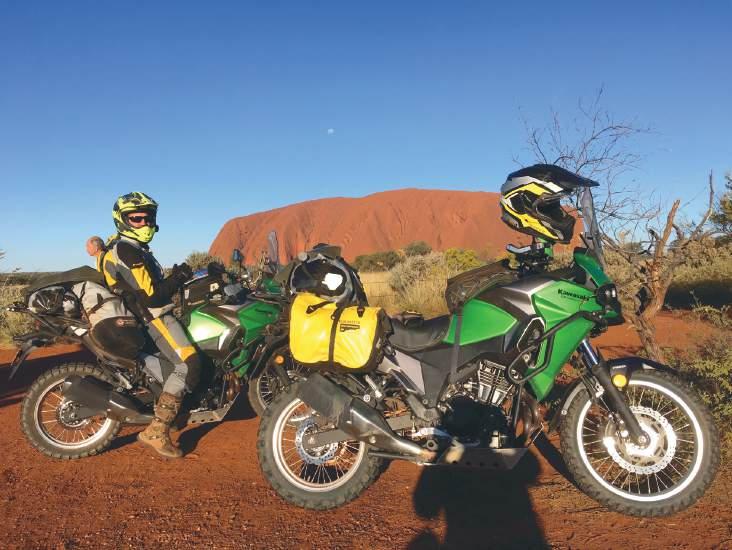
before, and while they’re safe to travel with at night, you couldn’t really ride above 80kph,” he said. “These ones –90mm – gave no surprises, are totally safe at 115kph, and are the best quality LED light I’ve ever used.”
Kawasaki’s accessory socket ‘adventure option’, which also came with a wiring loom, was fitted to enable a cigarette-lighter plug. A bracket, which doubled as a GPS mounting point, was made to move the windscreen up higher than the standard for more rider comfort.
The factory pannier systems are quite small with a three-kilo weight limit on each side, so Robin and Mick manufactured their own racks (“The easiest ones we’ve ever made!”), that used all the Kawasaki mounting points and also attached to the pillion peg for additional bracing.

Touratech’s new CLICK Endurance
soft-luggage system was used and gave a 28-litre capacity on each side.
“I wanted to test them to see if they’d cope in those conditions,” said Robin, “with corrugations and while carrying a decent load. They worked faultlessly. I took some extra straps in case the mounts failed, but we had no problems at all.”
A rubber splash guard was made to go from the swing arm up below the seat to protect the rear suspension from the worst of the dirt and mud and it worked really well, especially on the wet Strzelecki Track. An extended rubber flap was also fitted on the front mudguard, but it got caught up in the tyre and wore away.
Other modifications included replacing the standard gearshifter with a folding unit from a 1990s KX that was the right length and fitted straight on. The standard footpegs were also replaced with wider adventure units from a WR250 two-stroke. These required only small modifications to fit well.
Riding such great distances requires precision planning with little being left to chance.
Above: Riding across Australia doesn’t necessarily mean battling The Simpson and some of the tougher options. There are some major landmarks on easy riding routes.
Left: Robin used a six-light LED that offered exceptional performance.
At 10,800km, the East Versys West trip was a long one, but Robin Box is adamant that just about anyone can do it – and on just about any suitable bike.
“This is possible for most people, even if you haven’t done this type of thing before. Being familiar with maps and the language the maps talk is a critical skill. We always use Hema maps as the distances are very accurate. Check the age of your maps before you go, and get to know the icons on them, as they’re very trustworthy.
“In the outback there’s usually no phone service, so there’s no help. You make your own problems, and you make your own solutions.
“Do as much as you can properly before you leave. Have the vitals, but ask questions of people who have done it, and who are experts.
“We stopped in pubs more than tents, but had provisions to camp for two days if we became stranded. The outback is much bigger than the individual –what’s a small incident here becomes big out there.
“Prepare well, and brush up on your riding skills in looser conditions. Ride within your abilities, and don’t let your concentration relax.
“The speed you travel at needs to be safe, but you need to be engaged as well – meaning you’re not riding to a point where your concentration level drops off. You need a solid margin for error – and a big margin when the vegetation is close to the road and the chance of animals darting out in front of you increases. You can relax more in open country.
“Knowing where you are on the map is vital. It eventually becomes second nature, but knowing fuel consumption, or learning it in the early part of the travel when you’re closer to fuel stops, is essential.
“You need to also be aware of what influences your fuel consumption.
“Just as important is knowing the difference between a want and a need. Water is a need. Good coffee is a want!
“And enjoy what you’ve gone there for – the experience of what you get out of it will be far greater than what you don’t get (such as a good coffee). You need to take the critical things, not the luxuries.”
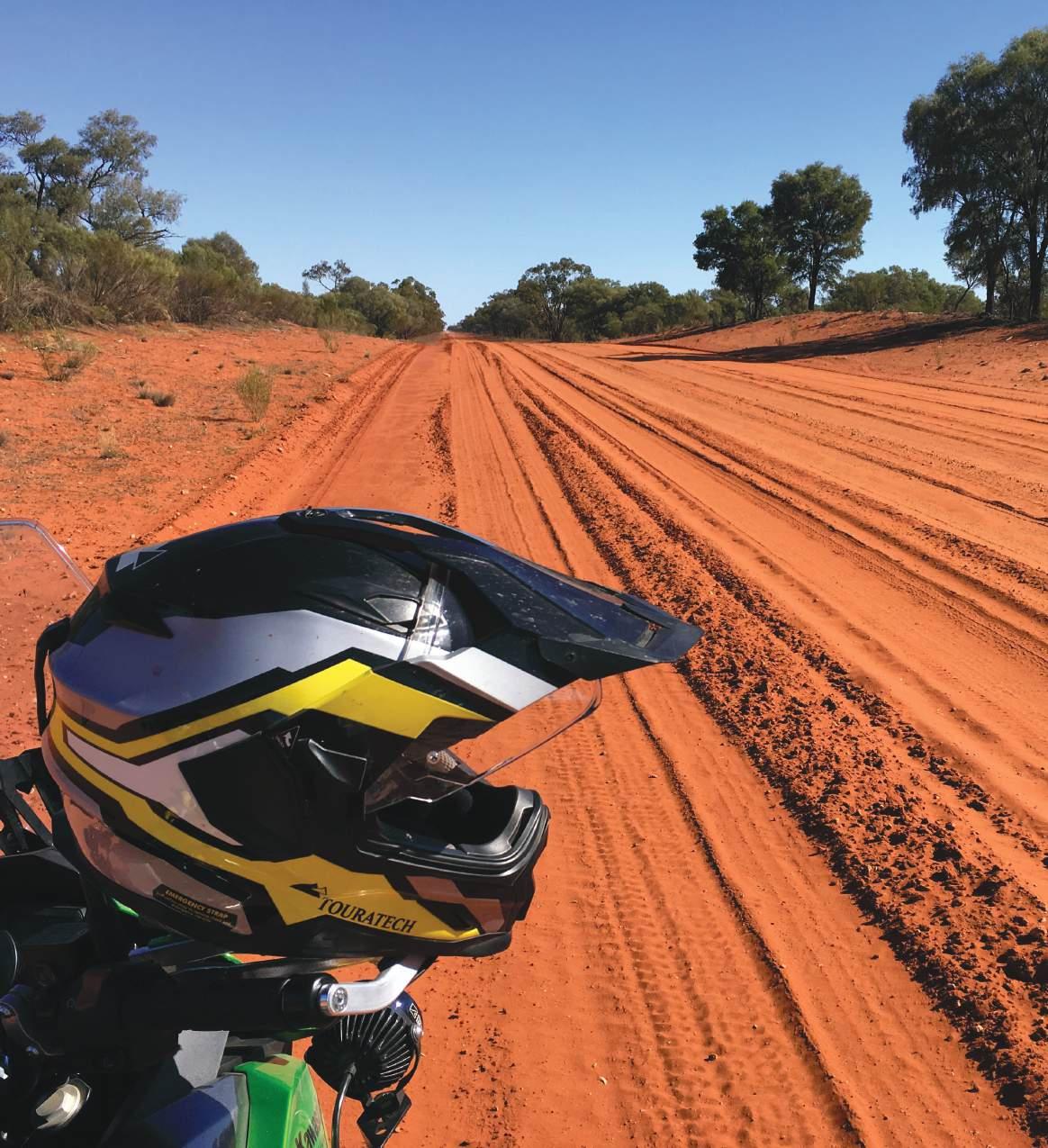





As with any outback travel, one of the first considerations has to be fuel economy. The Versys-X300 has a 17-litre tank and Robin and Mick found, for the most part, the bike averaged 21km per litre. That meant a fuel range of about 350km.
“The speedo does read a bit fast, but if you stay at 100kph in still conditions you can get 26km per litre and a range of 440km,” Robin explained. “If you never went over 80kph or 90kph you could average 400km per tank.
“We carried a fuel bladder with us, but only used it once in the run from Cameron Corner to Lyndhurst where we did 436km in strong winds while maintaining a constant speed.”
The pair did a few riding days of 900km, and the bikes did it quite comfortably, pushing at higher speeds when required and with seemingly little concern.
They encountered a small buzzing at certain revs, and while this took a few
days to pinpoint, it was eventually traced to the clutch lever.
Both riders used intercoms to stay in touch with each other when required, but also to listen to music or take phone calls on the long days.
On the ride from Victoria to Byron Bay it quickly became apparent the Versys-X went well in good road conditions, but its performance on the outback tracks was unknown. How would the bikes go in rougher conditions? And would they cope on the sandy tracks where bigger bikes are generally more stable?
“I can honestly say the bike has no nasty habits, and we didn’t have one unpleasant surprise from the Kawasakis,” said Robin. “They’re really predictable and stable, and their ability to cope in the sand, despite the lack of torque, was great. Riding was comfortable and easy, both sitting or standing.”
Tyres were another unknown. One bike ran Motoz Tractionator Adventurers front and rear, the other big-block Shinkos. Taking into account all the variations throughout the trip, the Shinko was found to be an easier tyre to ride on, and while they had less tread depth to begin with, they lasted longer. Neither bike suffered a puncture during the 10,800km, and even the 19-inch front wheel didn’t seem any real disadvantage compared to a 21-inch unit.
Importantly, neither bike suffered any mechanical issues during the ride, and even though no nuts were Loctited beforehand, nothing vibrated loose. The bikes required only normal servicing during the trip.












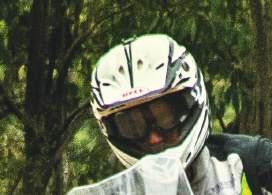















Looks like a show pony. Goes like a thoroughbred.

Main: Power delivery is predictable and controlled, but still offers plenty of excitement for those who want to cut loose.
Top right: A very late-1960’s, early-1970’s look.
Right: A cunningly hidden muffler box explains how the engine note is kept under control.

There’s nothing new in retro-looking bikes. There’s a whole lot of Japanese Harley lookalikes running around Australia’s roads, all with ‘the look’ of bikes from the golden era of V-twin cruisers but sporting up-to-date technology and equipment that makes them an absolute blast to own and ride.
Lately the scrambler idea has caught on with the dualsport brigade. The bikes all look like late-1960s British road bikes converted for off-road use, but, like the cruisers, have modern, high-tech equipment. Most of the bike brands have an example on offer, and we admit we thought, like the cruisers, they were probably just bikes put together from existing components and wrapped in plastic panels. Imagine our surprise when the Ducati Scrambler Desert Sled not only rolled straight out of our daydreams in the way it looked, but offered the kind of performance that left us somewhere just on the credible side of unbelievable.
Naturally the Desert Sled’s a V-twin. It’s a Ducati after all.
The 90-degree, oil- and air-cooled, Desmodromic V-twin is an 803cc, fuelinjected powerplant with a claimed 75 horsepower. The grunt drives through a six-speed box and chain via a cableactuated, wet, multiplate clutch, and service intervals are a healthy 12,000km.
The rear wheel’s a 17-incher, the front a 19-inch, and a reinforced frame and longer swingarm differentiate the Desert Sled from the other Ducati Scramblers.
As far as instrumentation goes, there’s only a single-dial LCD in a housing that looks like a speedo from the era, but offers a fair chunk of information from the usual trip meters and odometer through the strength of backlighting and a few other bits and pieces, the most essential being the switching of the ABS. There’s no traction control and a surprising – but very welcome – lack of other electronic rider aids.
It’s hard to consider a bike like this one and not take the appearance into account, and we felt Ducati, as always, had done a superb job when it came to the look of the bike. The cross-braced handlebars, the way the shock reservoir and muffler box are so cleverly hidden, the round headlight and even the shape of the seat and the way it
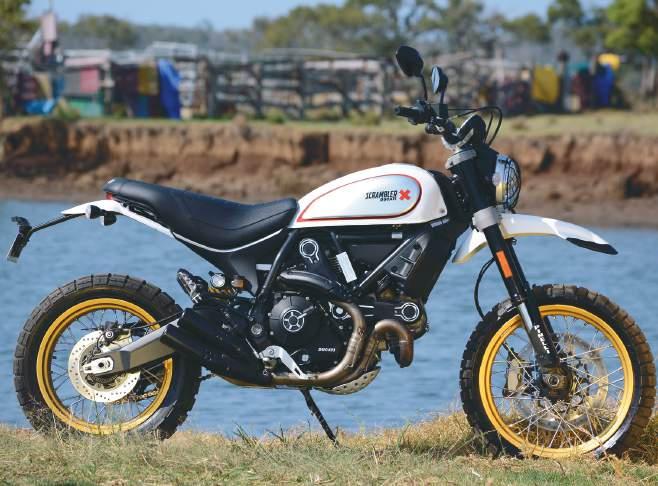
meets the tank are truly beautiful. The bike absolutely captures the era of the British scrambler with real style and true admiration for the period.
That’s what we reckon anyway.
We were all set for the Desert Sled to feel like a compromise. We thought Ducati would try and cram as much leading-edge technology as possible into the retro look and cut whatever corners were necessary to meet the marketing department’s approval.
When we first sat on the bike it was like tumbling back through time to our younger days. The look and feel of the cockpit, the big, round speedo, the ’bars with the crossbrace pad and the sparse, gimmickfree switchblocks took us straight to our happy place, and touching the start button had the surprisingly quiet twin burbling promises of a deeply spiritual motorcycling experience.
As we eased out the clutch, twisted the single-cable throttle and felt the wind cleanse the thoughts of work and responsibilities from beneath our openfaced helmet, we were transported back to when riding was something personal and meaningful. When that feeling of freedom was the reason we spent so much time daydreaming about bikes and where they could take us.
There’s a very emotional side to the Desert Sled for us, we admit it, and we think it’s fantastic.
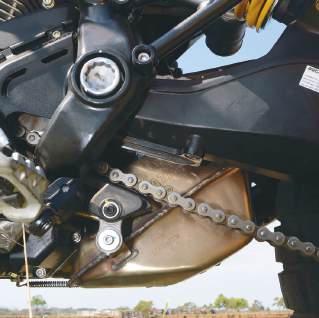
Moving away from the fanciful side of things for a while, the performance of the Desert Sled, judged by any standard, is exceptional.
The motor won’t frighten anyone. By today’s standards 75 horsepower is no big deal, but as we’ve been trying to get through to people for a very long time, horsepower isn’t the be all and end all of performance. The V-twin configuration and Ducati’s tuning mean the power is delivered in a very manageable, mid-rangey way that will allow the overwhelming majority of riders to get the maximum enjoyment from the powerplant and probably the best performance from themselves.
The engine’s lively enough to get the heart racing, but it’s happiest in around the middle of the rev range, say between about 4000rpm and 6000rpm. The
u

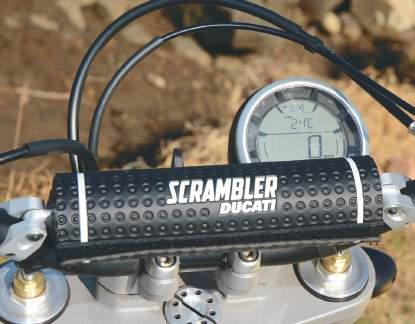


‘Desmodromic’ configuration means there’s no valve springs, so in theory the motor will rev like a mad thing, but it doesn’t enjoy being worked that way. It responds best when a rider carries corner speed and works to keep it on the boil –as opposed to using a point-and-shoot technique in and out of corners.
The motor is an excellent match for the other performance factors of the Desert Sled, and those other factors include some real beauties
The suspension and braking on this bike are exceptional. For us, they were high points in a bike that didn’t have any real lows.
Braking is awesome. There’s great feel front and rear and plenty of strength. We put the front to some very hard use, and even though it’s a single disc we couldn’t feel any slewing to the disc side. Ducati has engineered a very solid front end in there somehow. Normally we’d be calling for a fork brace, but not on this bike.
Now, the suspension.
We loved it. The front upside-downers are fully adjustable and the rear monoshock has preload and rebound adjustment. The action is excellent, but the feel is hard. There’s a real swing among adventure riders on big bikes to tune their suspension for comfort rather than performance, and those people will probably turn their noses up at the Desert Sled. But the performance is really, really good. On or off road, the bike can be sent full tilt into corners or rough going with complete confidence, and we did that a lot, so it was awesome for us.
The 19-inch front wheel meant turning was sharp and it felt great to see an erosion mound and not spend the seconds before impact wondering how much speed we needed to wash off to avoid a savage bottoming out. On the crappy outback roads the way to get the best from the bike was to push hard and let the suspension do its work.
1: The shorty twin pipes look the business, but they’re surprisingly quiet.
2: The big, round speedo and the ’bars with the crossbrace pad took us straight to our happy place.
3: An SAE plug and lead connected to the battery as a standard fitting. Nice.
4: Thank you, Ducati.
That meant at sightseeing speeds things were a little rough, but it’s the kind of compromise we wish we could make more often.
Each to his own, but suspension and braking on the Desert Sled got big, big ticks of approval from Adventure Rider Magazine.
What about the negatives?
The only things we could say against this bike really relate to the intended use and some specifics for individuals.
If your plan is to ride the big, long straights of the Nullarbor Plain or the Silver City Highway, you’re not going to be able to explore the best features of the Desert Sled. There’s a screen available, but handguards, luggage, nav and communication aids, cruise control and all the other perks that make that kind of riding so pleasurable are all missing from the stock bike, and to ride a bike like this one in a straight line on the bitumen is ludicrous. It’d be like buying a Ferrari to commute in capital-city traffic.
Taller riders might find the seating position a little cramped. Our 175cm test rider felt the ’pegs were just a whisker too close to the seat on long road stretches, but the clearance under the sump and 200mm suspension travel made that compromise worthwhile. Standing up was certainly comfortable enough, especially when the rubber footpeg inserts are removed – no tools needed. Just reach down and pop them out. Or in. Whatever.
Speaking of long stretches, the 13.5-litre tank will be marginal for adventure riders. The fuel light came on for us at 200km of mixed riding, and doing the maths suggests a range of 250km. That’s going to be a little uncomfortably tight for some sections of the Wide Brown Land.
The menu is simple and straightforward enough, but, as with any new bike, remembering which buttons to push in which order took a little time. The Ducati guys turned off the ABS to show us how it was done, and it took us until the end of our time with bike to work out how to turn it back on again. We were rapt the ABS doesn’t reset to the ‘on’ position every time the ignition’s turned on, but then felt a little foolish when we couldn’t work out how to make it happen when we wanted it.
The ABS works fine, by the way. The only options are on or off, and it applies to front and rear, there’s no in betweens.

Above: Ducati’s Scrambler Desert Sled doesn’t just look the part. It delivers with strong performance.
While we were carried away by the Ducati’s performance there were some really nice details that impressed us.
The first was a good toolkit.
It’s held under the seat with a rubber band, and includes a pair of plastic tweezers to remove fuses. Anyone who’s struggled with those small motorcycle fuses will know why we’re so impressed. The rest is a small set of the usual tools needed for standard adjustments, but Ducati includes a tool for adjusting shock preload. It must be a common inclusion on Ducatis because we’ve seen it before, but we loved the thought.
We also loved the USB power outlet under the seat and the SAE plug and lead attached to the battery. They’re two fittings we routinely add to every bike these days, and that Ducati has already put them in place shows a great regard for its customers, we reckon.
The Desert Sled handles like a rat on rails and brakes and turns with precision. It pounds over rough ground with real authority. It doesn’t feel heavy or unwieldy and offers performance good riders will use to make sports-bike riders feel foolish without giving up too much to more focussed off-road dualsporters.
Best of all, the look and feel truthfully captures the atmosphere and emotion of the bikes and attitudes of the late-1960s and early 1970s motorcycling era.
It’s a daydream made reality.

ke spe C s
BWeb: www.ducati.com.au
Engine: L-twin, Desmodromic distribution, two-valves per cylinder, aircooled
Capacity: 803cc
Bore x stroke: 88mm x 66mm
Compression Ratio: 11:1
Power: 55kW @ 8250RPM
Torque: 68NM @ 7750RPM
Fuel injection: Electronic fuel injection, 50mm throttle body
Exhaust: Stainless-steel muffler with catalytic converter and two lambda proves, aluminium tail pipes
Standard: Euro 4
Consumption and emissions: 5.1 litres per 100km –CO2 119gm/km
Transmission: Six-speed
Clutch: APTC, wet, multiplate with mechanical control
Final drive: Chain. 15-tooth front sprocket. 46-tooth rear sprocket
Frame: Tubular steel trellis
Front suspension: 46mm, fully adjustable, USD forks. 200mm travel
Front wheel: Spoked, 19-inch aluminium wheel
Rear suspension: Kayaba rear shock, preload and rebound adjustable.
Aluminium, double-sided swingarm. 200mm travel
Rear wheel: Spoked aluminium, 17-inch wheel
Front brake: 330mm disc, radial, four-piston, floating calliper with ABS as standard equipment
Rear brake: 245mm disc, single-piston floating calliper with ABS as standard equipment
Dashboard: LCD
Wheelbase: 1505mm
Fuel capacity: 13.5 litres
Dry weight: 191kg
Wet weight: 207kg
Seat height: 860mm
Maximum height (at brake reservoir): 1213mm
Maximum width (mirrors): 940mm
Maximum length: 2200mm
Number of seats: Dual seat


Adventure Rider Magazine’s Congregations are in their third year, and even though there’s still one to go, this has already been our best year ever.
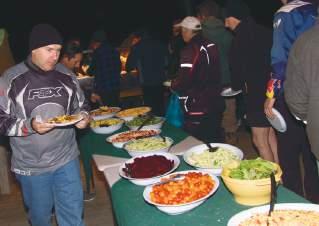
Green Valley Farm in Tingha, NSW, not far from Inverell, was the venue for the 2017 northern Congregation. After the raging success of 2016 it would’ve been crazy to go anywhere else.
The weather for this year’s adventurerider get-together was even better than last year’s. The sun shone, the temperatures were moderate and something like 260 riders made their way to the New England region to enjoy the atmosphere, swap a few yarns and do a bit o’ ridin’.
There was plenty going on, starting with the anniversary celebrations for Vince Strang Motorcycles.
The Suzuki dealer clocked up 40 years on the same weekend as the Congregation and shared the good news with everyone by hosting a free sausage sizzle on Friday arvo. It was also 21
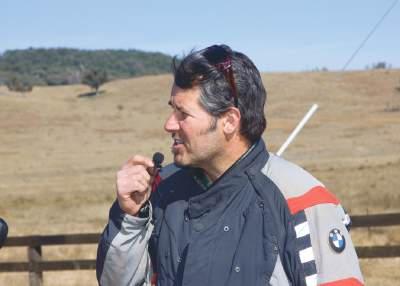









years since the release of the DR650SE, and, with Vince himself being The Man where that bike was concerned, an allout shindig was in order. Having the Congregation just around the corner from Vince’s store made it a dead cert for the massive pack of DR riders to lob in and share the DR love.
And they did. Vince had mapped out a couple of loops and was good enough to share the GPX files with all Congregation attendees.
Once again the Vickery family – owners of Green Valley Farm – made sure everyone was registered, fed and kept warm with plenty of food, fun and firewood. The whole event ran as smooth as a Husky 701 Enduro, and it was in no small part thanks to the attention of the Green Valley Farmers. They had 24 members of the extended family working hard all weekend!
Of course Miles Davis’ skills demos were
as eye-popping as ever, Vince Strang himself gave a tyre-repair demo, a few prizes were handed out for achievements like oldest and youngest rider, bike with the highest kilometres and so forth, huge amounts of food were consumed, a shandy or two shared around the firepits, and a hugely enjoyable, beautifully managed weekend went off in the best possible way. It’ll be hard to top this Congregation next year, but we’ll be trying.
Above right: Bumot made the journey to Tingha and had some seriously tough adventure gear on display.
Right: Karen and Mal from Adventure Bike Australia were on site in Tingha with their range of premium adventureriding equipment.


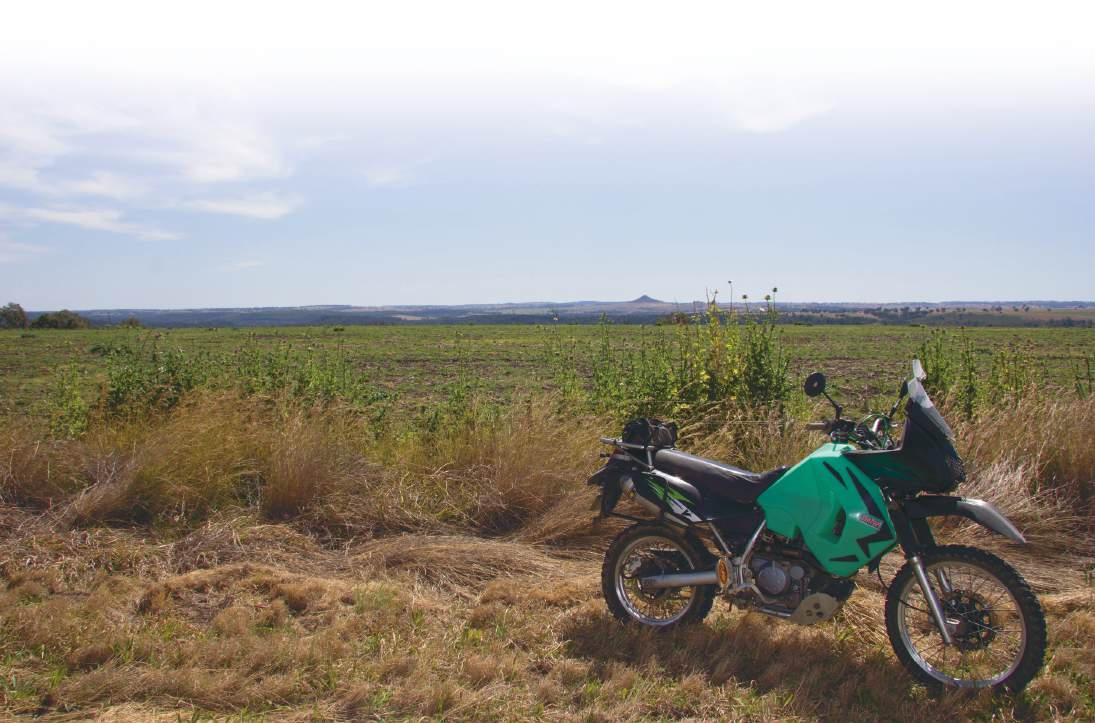
Vince Strang’s loops around Inverell had something for everyone. There was awesome open scenery on an ‘adventure’ loop and tough terrain on an ‘enduro’ loop.


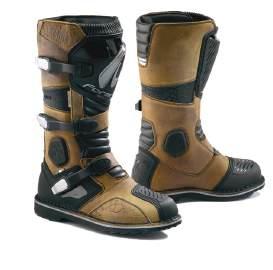



As the sun set on the third northern Congregation the Adventure Rider Magazine crew packed its bags and headed to Perth for the first-ever western Congregation.
The folks at Motorrad Garage had taken on the running of the event and even set the mag’s editor up with an SW Motechkitted KLR.
The event itself ran at the hilariously named Loose Goose Chalets at Nannup, about 250km south of the capital on the main road. Fortunately, Motorrad Garage isn’t a ‘main road’ type of business, and a very pleasant run of five hours or so through the Western Australian bush made up most of the Friday before the official start.
They sure do have a lot of pea gravel in West Aussie. It’s like hundreds of kilometres of little ball bearings, and the ed reckoned it made the KLR feel like it had a 100 horsepower…but perhaps he was just making an excuse for when he dumped the Motorrad Garage display bike in the crud.

Top: Miles Davis was in WA for the BMW Safari and dropped in to do his magic.
Anyhoo, Loose Goose Chalets was the destination and the rides down and back were premium.
It seemed too good to be true, but the weather in West Aussie was every bit as good as the weather had been in NSW. The days were filled with glorious sunshine and clear blue skies. Laraine and Grant at Loose Goose started churning out the tucker on Friday night and, along
Above: Fred (left) and Andreas Powell had everyone spellbound with the story of their 1983 run along the Canning Stock Route, complete with old-fashioned slides and movies.
with the blokes from Nannup Men’s Shed, didn’t stop all weekend, keeping 130 or so hungry riders in good shape.
Left: Any time riders weren’t roosting in the Nannup forests the scenery was glorious.
Right: Ed Brown’s on a mission to make all three Congregations in 2017. That meant riding his schmick-looking Yammie across the country to Nannup. No problem for Ed. He loved it!

u
Miles Davis was in town for the BMW Safari and lobbed in to show the West Aussie adventure riders his form. They were left as gobsmacked as everyone else who sees him throw a 1200 around.



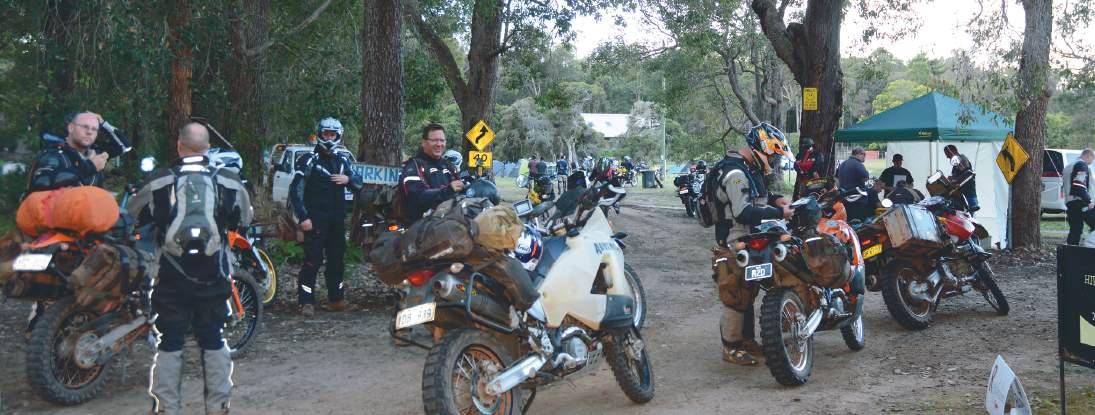
In this case it was a 1200GSA, so, if possible, it was even more astounding than when he does it on a GS.
There was a little grasstrack-motocrossing going on at one stage, just for the camera, and the appreciative onlookers were treated to the rare sight of Miles decking the big bike in the soft sand.
How come no-one showed the same hero worship when the editor stacked the KLR at 10kph on the treacherous, deceptive pea gravel?
It’s a mystery.
While the basic running of the Congregations is fairly set now, each one has it’s own unique offerings, and Andreas and Fred Powell’s presentation of their first-ever unsupported ride down the Canning Stock Route in 1983 was undeniably the standout event of the whole western Congregation.
Those two cheerful blokes went to huge lengths to bring the ride to life, including showing the remains of the two bikes they rode, displaying bits and pieces of the original equipment they carried –like the Super 8 movie camera and the humungous Royal Flying Doctor radio with the 40-foot aerial – and even some of the gear they actually wore on that trip.
Best of all was the Super 8 film and slides.
Yes. Slides.
The two fellas announced they were ‘taking everyone back to 1983’ and set up an old movie projector and an equally old slide projector to show the fascinated Congregation the challenges they faced and conquered.
Everyone was mesmerised. It was brilliant. The film and images were digitised and a large-screen TV was on hand in case the old gear wasn’t up to the task, but the style of presentation transported everyone to a time before GoPro and sat phones and helped give a taste of just how monumental was the achievement.
That’s not ignoring the loops Motorrad Garage had recced and made available, the awesome campground with its soft turf and carpet of dandelions, the amazing wildlife and the incredible, friendly atmosphere of the whole show from start to finish. And of course the prizes to deserving riders.
It was fantastic to be part of it all.
As we write this there’s still the southern Congregation at Dargo River Inn to go. By the time you read this it’ll have run and the 2017 Congregations will be over.
But the burning enquiry on everyone’s mind will be, ‘What about 2018?’
Exactly. What about it? Will there be three events again next year? Could they possibly be as good as the 2017 gatherings?
Time will tell.
Right now we have to get packing and head for the Victorian high country. We’ll let you know how that one went next issue.

Above: A great turnout for the first western Congregation, and a real credit to Motorrad Garage and Loose Goose Chalets for first-class catering and organisation.
Below: There was fabulous old machinery scattered around as decoration at the Loose Goose Chalets.

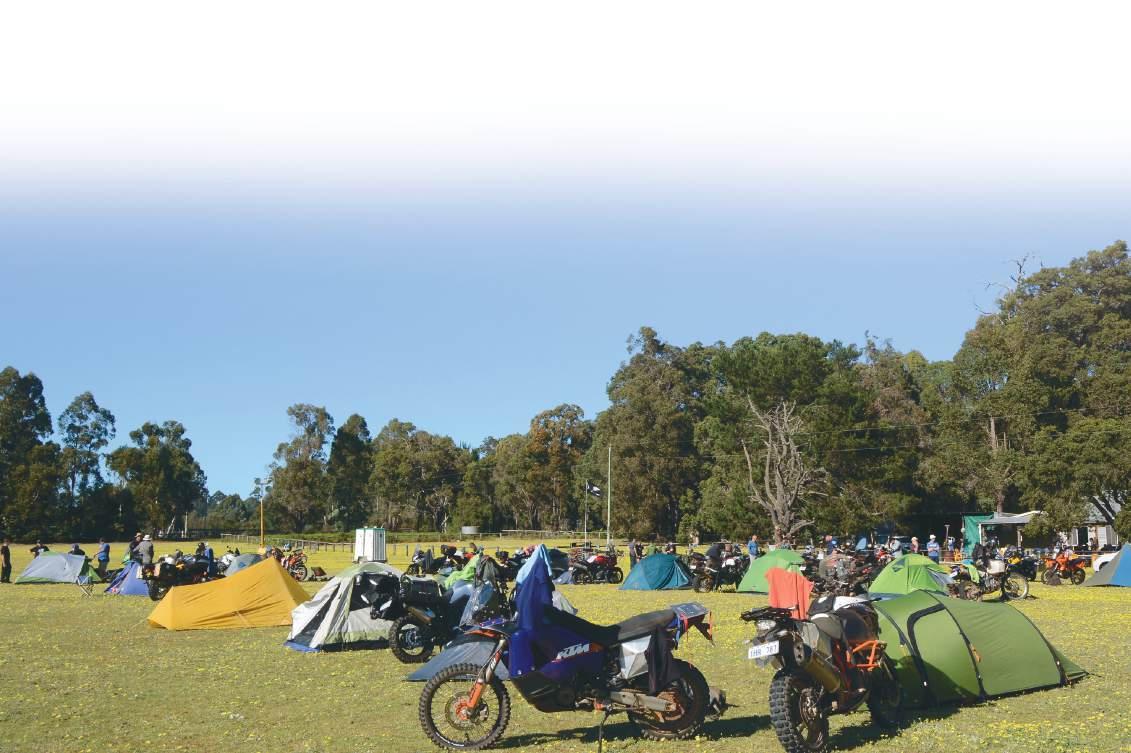
Right: The blokes from Nannup Men’s Shed kept everyone topped up with bacon-and-egg rolls.
Below: A fabulous camping area at Loose Goose Chalets.




vNovice adventure rider Will Fennell took on the infamous French Line and the Corner country with fellow riders from the SA BMW GS Riders group. When rain called an early end to proceedings he and his riding mates didn’t hesitate to head back out and finish the ride as soon as the opportuntiy was there.

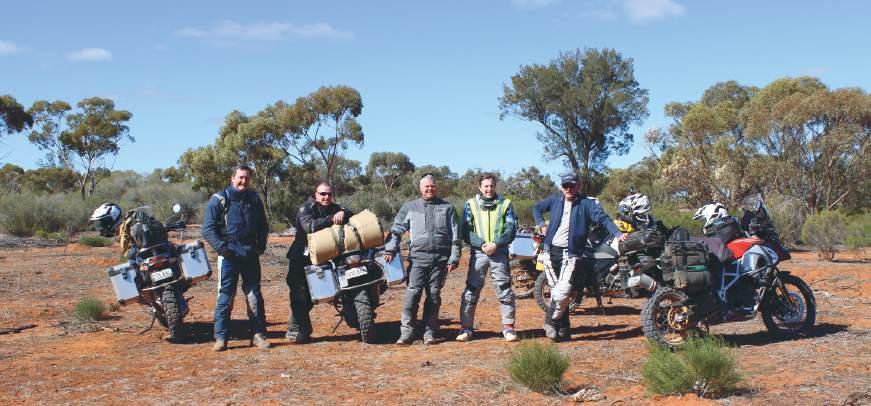
Main: A cracking bonfire near Cameron Corner and the best night skies anyone had ever seen.
Above: Lunch on the first day of the second trip. Just North of Danggali Conservation Park.
Iwas about two-thirds of the way up a seemingly innocuous dune when suddenly I lost momentum, dug the front in and abandoned ship. The bike was laid over facing diagonally across the dune with the seat downhill and there was no chance of picking it up where it lay. The silver belly of the skidplate lay glistening in the afternoon sun and sweat began to bead from my every pore. I contemplated what it might mean for the rest of the group if the dunes of the infamous French Line had finally begun to get the better of me.
My journey to the Simpson started 12 months earlier on the 2016 BMW Safari Enduro from Streaky Bay to Broken Hill.
I was an absolute novice on a bike then, but with a lot of encouragement from others on the ride I made it to Broken Hill in one piece. More importantly though, the BMW event gave me the opportunity to meet a group of fellow GS riders from South Australia: Brett Allison, u

Stephen ‘Harry’ Harris, Steve Trestrail and James Powell. After the Enduro we started the ‘SA BMW GS Riders’ Facebook group and less than a year later found ourselves on the adventure of a lifetime, crossing the Simpson Desert.
The crew
Australia’s central deserts have always been deeply alluring to me, and if I’m honest, that allure is probably just as much about the associated bragging rights of conquering the desert on a motorcycle as the thrill of the ride itself. So, on something of a whim and not expecting any serious commitment, I asked the Facebook group if anyone was interested in a Simpson crossing. Pretty soon we had Brett and Harry raring to go on F800GSAs and me on my trusty and substantially lighter G650GS Sertão. But even better, Steve Trestrail, who’d ridden
Above: A cattle grid north of Broken Hill gave Brett some ’bar wobble.
Below: Birdsville meant time for a new rear tube, air filter and general check over.

a 1200GSA on the Enduro, volunteered two work utes as support vehicles. Steve’s 10-year-old son Elliot would also join us. Steve’s mate Carlo Russo volunteered to cook while another mate, Jason Sifis, offered to drive the second support vehicle.
James Powell, also on the BMW Safari, would tag along in his own 4WD with 85-year-old ‘Uncle Andy’ for company .
To prepare for the desert, the three riders met on Goolwa beach for a few practice runs in the sand.
It was obvious from the get go that neither Brett nor Harry needed any practice, but it was nice of them to pretend otherwise for my benefit.
After many low-speed tankslappers and
a badly bruised ankle – pannier racks hurt! – I developed some very basic sand-riding skills which I hoped would be enough to get me across The Simpson.
Once the final group of riders and support crew was assembled, we setup a Google Docs spreadsheet to manage the planning. It turned out to be a great tool for organising group rides, especially when everyone lived miles from one another. After several changes of itinerary we eventually settled on a run up the Oodnadatta Track from Adelaide to Mt Dare, over The Simpson from west to east, then down to Innamincka and Cameron Corner via the Strzelecki Track. We also setup a Facebook Messenger group to discuss the minutiae of
u
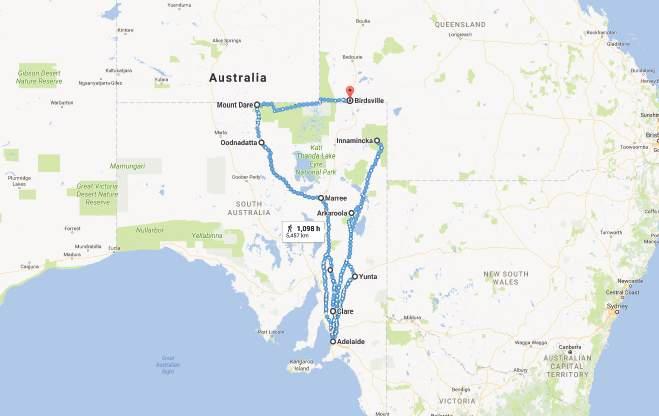
For video of Will’s Simpson trip see https://www.youtube.com/watch?v=JP6DWAlhcaE or log on to Youtube and search ‘Simpson Desert Motorcycle Adventure’.

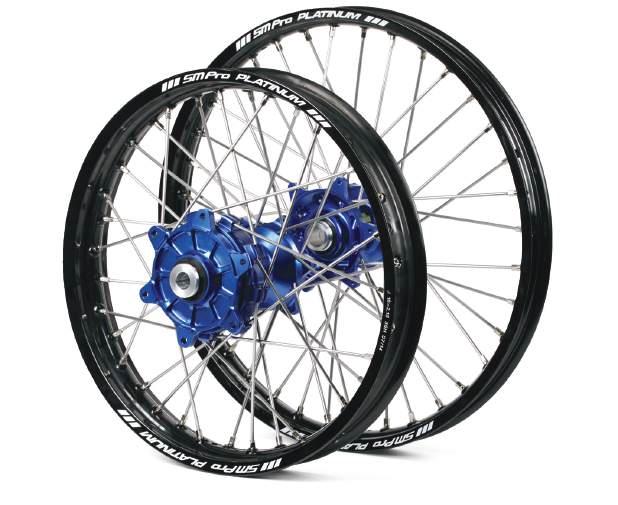




planning details, which quickly became a nuisance for our respective wives who complained of constantly distracted husbands and buzzing phones at all hours.
After a rendezvous in Clare on a Friday morning we set off for Maree where we managed to get a nice cold beer served with a smile from some even nicer Irish backpackers. Better still, we got our group ride sticker up on the pub’s fridge, which we hope will be there next year, even if the Irish backpackers aren’t.
After an obligatory picture of Tom Kruse’s mail truck just before sunrise we all headed for Oodnadatta, and when we reached Algebuckina Bridge early in the afternoon we realised the riverside was too good to pass up. It made a great camp for the night and we highly
recommend the spot if you’re heading that way.
After stopping the next morning at Oodnadatta for fuel, we set off past Mt Sarah Station towards Mt Dare. By that stage we’d an established running order. Brett, now known as ‘The Greyhound’, was usually in front, Harry followed and Yours Truly happily putted along somewhere in front of the support vehicles.
At Mt Dare Harry and I realised Brett was missing and concerns were raised about the prospect of a badly injured rider lying unseen off the roadside. Lucky for everyone, Brett was wearing a SPOT tracker, so a quick call to his missus – who could access the internet to see his location – established he’d taken a 120km detour towards Marla and was still making his way to Mt Dare.
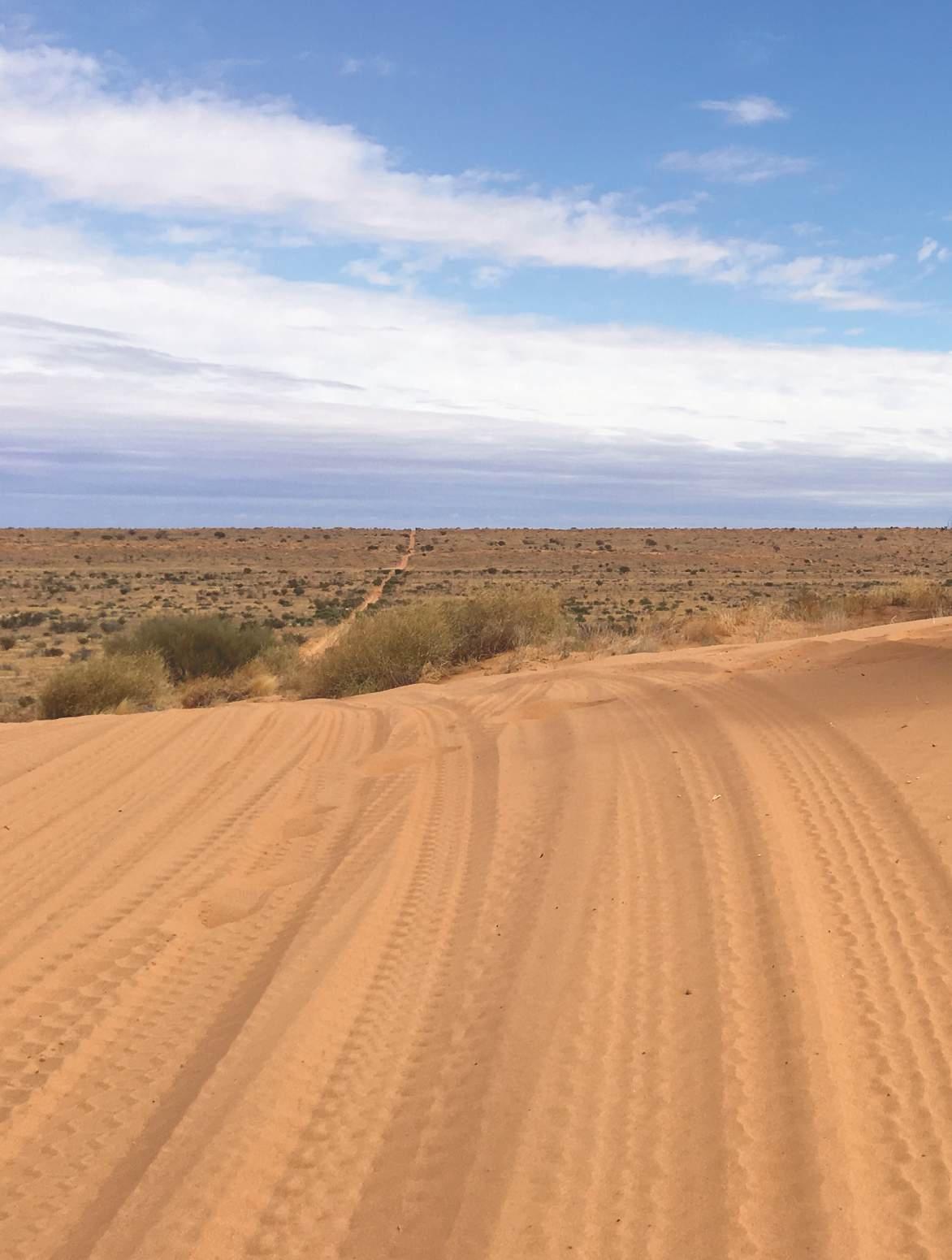

After giving Brett a light ribbing on his arrival we made our way to our campsite about 30km west of Dalhousie Springs.
The French Line
We’d planned a three-day French Line crossing from Dalhousie to Birdsville, starting with a long soak in Dalhousie Springs. It was a particularly cold and sunny morning as we peeled off the 30km or so to Dalhousie, perfect conditions for a swim in the 38-degree springs.
Nervous about the looming desert sands, I got out ahead of the others and headed off into the desert. I wasn’t
Main: Loving the sand between Poeppel Corner and Birdsville.
Left: The author found there was no need for a centrestand on Big Red.
worried about being on my Pat Malone because I knew Brett and Harry would catch me in no time. Sure enough, the 800s came whizzing past before I even got to Purni Bore.
All riders made the first day’s Simpson camp in one piece and without incident, but the vehicle drivers and passengers began to realise a three-day crossing was actually pretty challenging in a vehicle. Being bounced nonstop all over the shop as the cars crawled along the dunes at a measly average of 13kph was exhausting.
On day two it was agreed everyone had to get to Poeppel Corner by nightfall if we were to have any chance of getting across in three days. Perhaps that ambitious plan is what landed me in the spot of trouble which opened
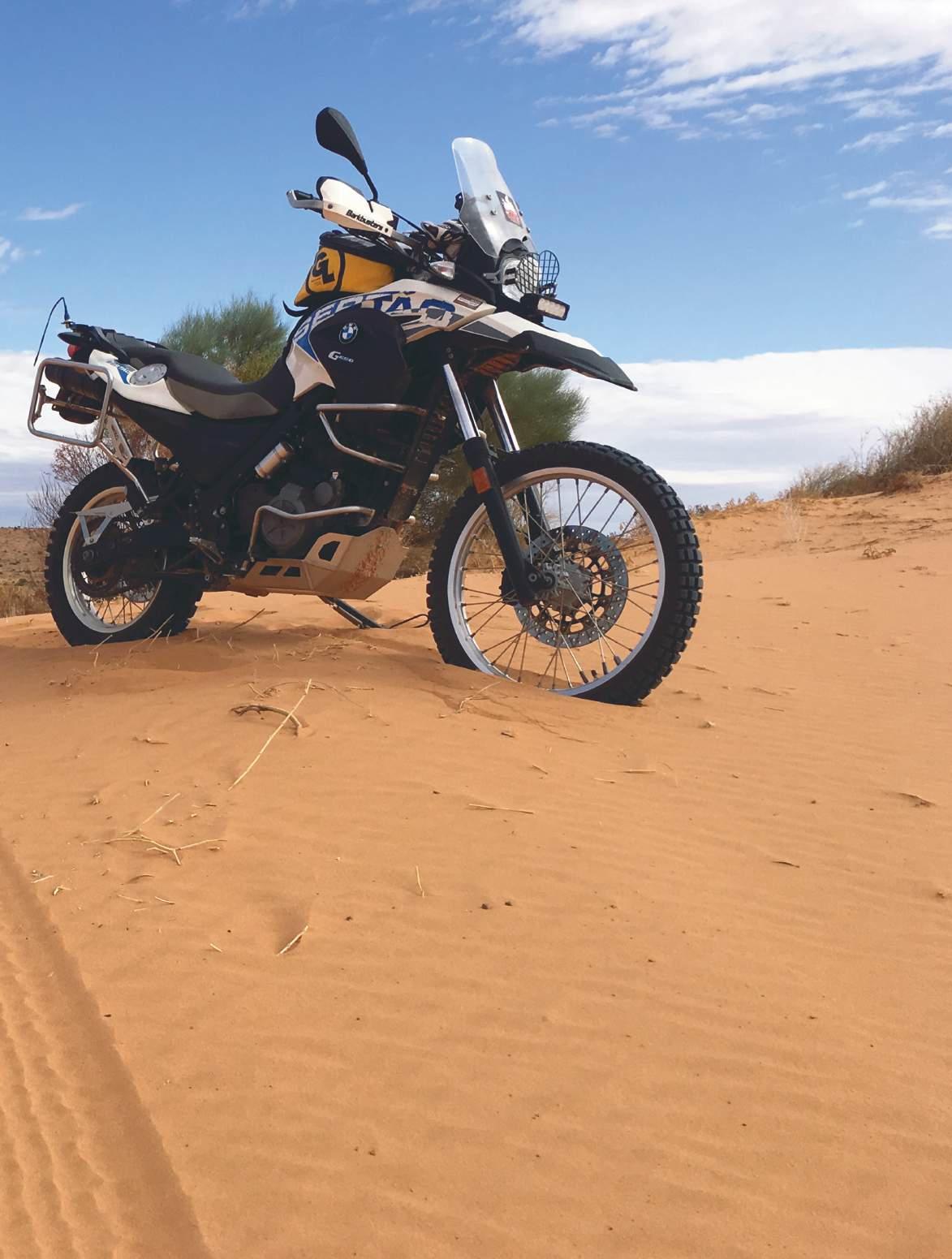


this story: stuck on a dune with the bike in an uncomfortable position.
Remembering some advice, I dragged the front wheel back downhill and dug two holes under the wheels with my hands. Mustering every last bit of energy left in me, I stood the bike up in those holes, climbed back on and rode off the dune. Then I just sat there, engine off, thinking about what to do next. I was sure I couldn’t endure that process a second time.
After a quick pep talk to myself I fired up the Beemer and accelerated quickly up into second gear. I hit the base of the dune with a lot more momentum and a steady throttle, sailed past the crash site and over the top, laughing at how much easier it was at that pace.
The rest of the way in to Poeppel Corner was an absolute joy. I’d finally developed real confidence in the dunes, and was at one with the bike rather than a nervous passenger.
That day in The Simpson was probably one of the biggest steps forward in my development as a rider.
Arriving at Poeppel Corner I learned Brett had been waiting there most of the afternoon being fed and watered by passing 4WDs. Harry had spent some of his afternoon mustering camels on his F800GSA. The speed and ease at which those guys were getting across the desert on those heavier 800s impressed me greatly.
The third day of our crossing was incredibly enjoyable for all three riders, and as Big Red approached there was a sense of achievement, but also sadness, as our epic desert crossing came to an end. The dunes on the QAA line were tall but firm, and the only real challenge was getting down dunes badly scalloped by 4WDs heading east.
After a photo on Big Red with Harry (The Greyhound had been and gone), we headed for the outback oasis of the Birdsville Hotel.
On the way in, and just as the silhouette of the Birdsville Hotel came into sight, I learned the hard way that sand tyre pressures don’t work on hot bitumen. With a dead-flat rear, no spare tube and

Above: A flat on the way into Innamincka. A couple of plugs had the show back on the road.
Below: The obligatory picture of Tom Kruse’s mail truck just before sunrise at Maree.
eager to enjoy a celebratory ale, I decided to go for broke and coasted into Birdsville crouched over the front with flapping rear rubber. Lucky for me the Conti TKC80s did a great job in protecting the rim from my impatience.
Sitting in the Birdsville Hotel waiting for the support vehicles, the three riders watched the weather close in and a light rain come down around the pub. Although brief, it was apparently enough rain to close the roads for a day and put a serious damper on our plans to get to Innamincka. So after an unplanned rest day in Birdsville and our desert challenge completed, we headed back to Adelaide via the Birdsville Track and an overnight stop at Arkaroola.
But wait. There’s more
Shortly after returning home the desert beckoned again, and soon enough Facebook Messenger fired up with talk of another outback trip. Naturally we decided to complete the journey we’d started. That meant a run up to Innamincka via Broken Hill and Cameron Corner, then back down the Strez, but this time we abandoned the luxury of the support vehicles and a cook and carried our own gear. In addition to Brett and Harry on their 800s we had Steve Trestrail on his 1200GSA, Richard Shipman on his 1200GSA and Tony Shuman, also on a 1200GS.
u

From Adelaide we headed to Morgan on the blacktop then up the Morgan mail road past a number of stations and Danggali Conservation Park. It’s a great alternative route to the Barrier Highway, although the local station owners say the tracks are a ‘mare on a bike if there’s been rain’.
After a night in Broken Hill, Tibooburra to Cameron Corner proved most interesting, and I had my first near miss with a ’roo late in the day. Taking the advice of a road sign to keep left, I came over a steep crest only to have a startled ’roo dart out in front. Thankfully he changed tack about a bee’s appendage before connecting with my front wheel. My heartbeat about matched the revs of the Sertão’s thumping single cylinder all the way in to Cameron Corner. At The Corner Tony opted for a room and a meal in the pub while the rest of us went a few kilometres out of town and camped. Apparently there isn’t any free bush camping at Cameron Corner, but given the guy that makes those rules also holds the key to the only fuel bowser wthin 160km, who were we to argue?
We settled in around a cracking bonfire and enjoyed one of the best night skies any of us had seen.
Crow barred
Heading north to Innamincka we enjoyed rolling, clay-capped sand dunes and great station roads. Before the trip Steve had been wary of sand on his 1200GSA, but reckoned he found his sand legs that day. He copped a flat as we passed through the Strzelecki Desert, but a couple of tyre plugs had us back in business.
After an obligatory stop and photo at the Dig Tree we headed to Innamincka. Most of the group decided to take hotel rooms, but Brett and I headed to a great camping spot on Cooper Creek, just out of town, with a six pack, a bag of ice and a couple of steaks from the general store. The camping that night was even better than Cameron Corner, although we learned not to leave food out and go swimming. The resident crows are experts when it comes to timing a camp-kitchen raid.
From Innamincka we took the old Strez then the new Strez down to Arkaroola. It was a decent 450km run and I underestimated how much water I needed to carry, even in mild weather. Lucky for me Brett’s an old hand in the outback and had a spare water bladder to split with me just as dehydration was about to take hold.
After a night in Arkaroola we headed back home via the Frome Downs Road and Yunta. With a strong crosswind and a 600km journey on roads wanting to see a grader, we all got home exhausted but utterly pleased with another successful trip.
Since our return Facebook Messenger has of course fired up again, and plans for next year are taking shape. We’re calling the next one ‘The 2018 Transcontinental’. It’s going to be a ripper of an adventure up the Tanami and Gibb River Roads to Darwin.
And yes there’s already a spreadsheet.


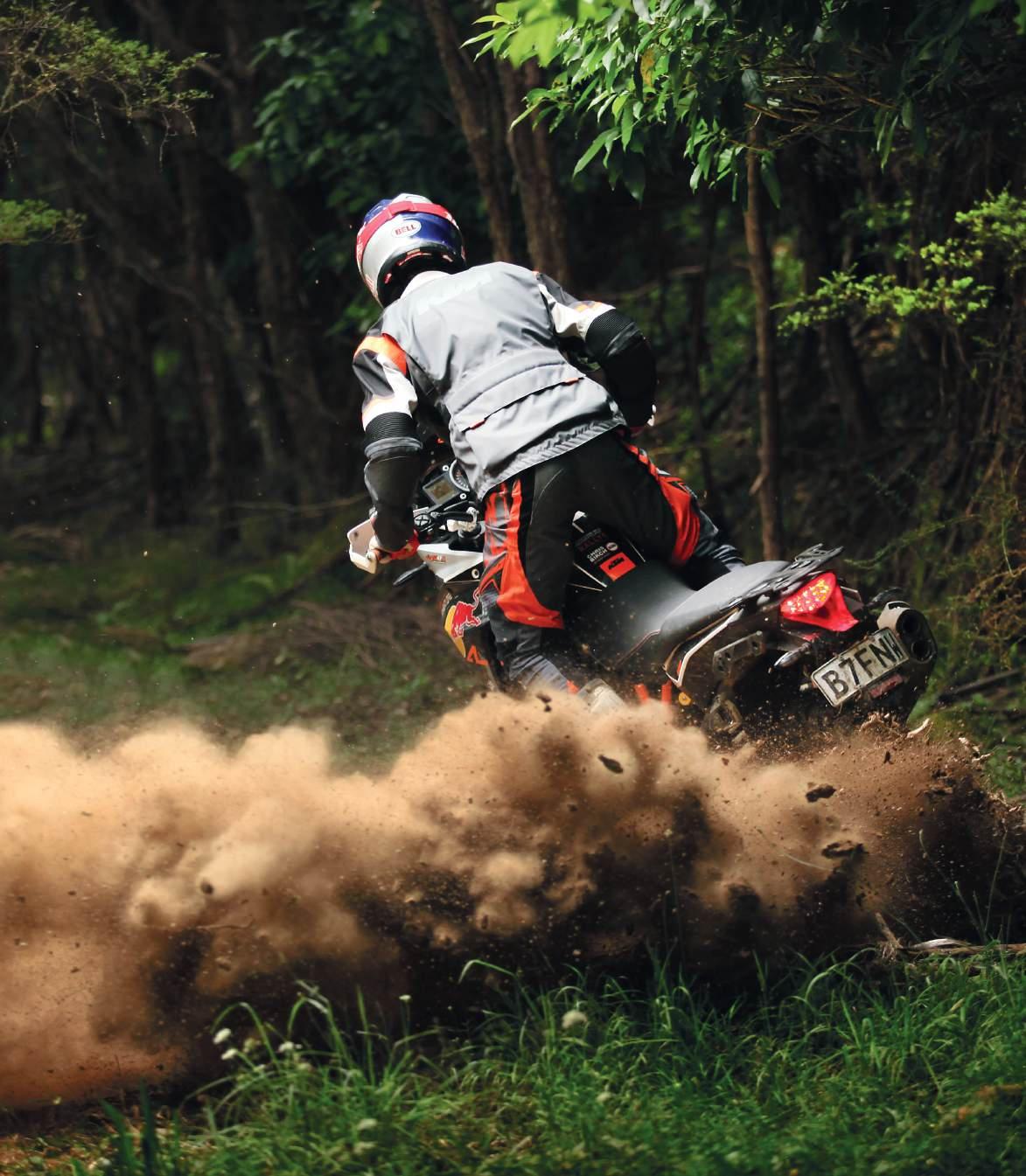





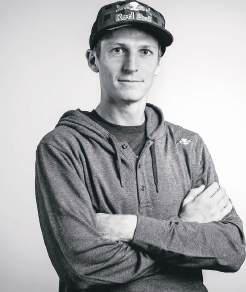

A flat tyre out in the mulga is sure to wipe the smile off any rider’s face, but adventure riders have a special set of challenges. Breaking the bead is one of them.
There’s a lot of pressure on an adventure rider over a tyre repair or change. For starters the bikes are usually heavy and the terrain unsuited to suspending a bike with a wheel off the ground. Once that’s accomplished, the big horsepower nature of modern adventure bikes usually means the tyres are held fairly firmly to the rim, especially the rear rim.
That firm grip, necessary to cope with the drive and torque in the absence of rim locks, and especially with the seal needed for tubeless rubber, means the basic process of breaking the bead on the tyre becomes a problem.
It’s not only the big-horsepower glamour bikes, either. DR650 owners will know what we’re talking about.
Adventure Rider Magazine decided to have a look at a few alternative solutions to the bead-breaking dilemma.
Before everyone reaches for their credit cards and starts applying financial leverage, lets consider a few basic bead-breaking methods.
The second is warming the tyre.

The first is jumping on the tyre wall. If that works, you’re in.
That’s a polite way of saying ‘ride on the flat tyre until it heats up enough to free up the bead’.
We don’t recommend this because the chances of damage to the wheel, tyre and, if there is one, tube, are high. But if it’s a choice between sitting in the desert and waiting to die or risking wheel damage, we’ll take our chances. We’ve done it in the past. The only thing we can suggest is to keep the rider’s weight off the effected wheel as much as possible and to keep the riding distance to the barest minimum.
The other basic technique we’ve used often and do highly recommend is to use the sidestand of another bike to pop the bead.
Drop the sidestand of a mate’s bike, put the foot on your deflated tyre as close to the rim as possible and let the weight of the bike – often with a little added weight from the rider –do the rest. It works most of the time.
We’ve had a few instances where the sidestand wouldn’t break a bead though, and that’s when some heavy-duty alter natives are needed. Usually that means some type of specially designed equipment.
Oh look! We have a few examples right here…
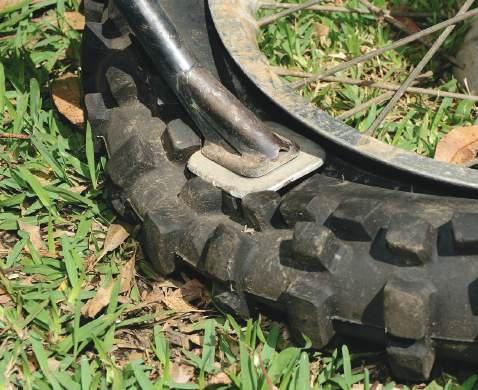
Above: Using the sidestand of another bike to pop the bead is the go-to method on a ride.

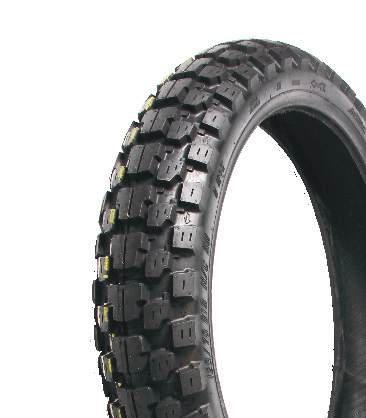





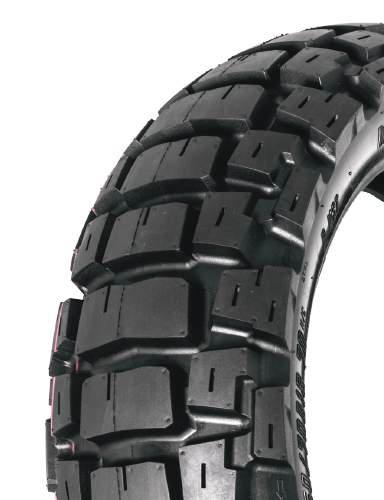



In general Motion Pro makes good equipment.
The BeadPro is a pair of tyre levers that fit together to form expanding jaws designed to force down a stubborn bead. Once that’s done the levers flip end-for-end and become regular tyre levers.
That’s straightforward enough, and for general use the system has a lot going for it. The levers make for a compact package, they’re light and strong, and they’re as simple as can be to use.
But…
Well…
We just couldn’t get them to cope with really serious jobs on tubeless and big-bike beads. A couple of times they did the business, but a couple of times we gave up.
On top of that, we didn’t warm to the shape of the levers when it came time to remove the tyre. We like the hookshaped ends we hardly ever see these days. The large, flattish spoons are supposed to be less likely to grab and pinch a tube, but we find they don’t grab the tyre too well either.
But that’s just us. And with a little


concentration and persistence on the part of the operator, the BeadPros will peel a tyre off a rim just fine.
Certainly on the KLR tyre we had they rocked. We found breaking the bead was sometimes a two-step process where we jammed the two levers under the rim, squashed them together to move tyre a little, then jammed them in again a little further and squeezed again and we were good to go. But on a DR650 rear wheel in a bad mood we were left in doubt. DR rears are tough at any time, and we had one with a Mitas 09. That’s a tough combo, but a common one, and we couldn’t
Above: A Mitas 09 on a DR650 rear is a tough combo, and it took a lot of work for the BeadBreakers to get the job done. It wasn’t a 100 per cent result.
Left: The BeadPros are light and compact. We bought ours from Adventure Motorcycle Equipment.
Below: Tyre levers one end, bead breakers the other.
give the Motion Pros top marks. Sometimes we could get a result, especially with two riders on the job, but not always.
We bought our pair from Darin at Adventure Motorcycle Equipment for $135 plus postage.



Tyrepliers is an Aussie company specialising in tyre-changing and repair equipment for all kinds of vehicles from big trucks on down. The company offers a heap of wheel-repair accessories as well.
The Motorcycle Bead Breaker has been around for ages, and the example we’re using here has been the editor’s for a decade or more. It’s his second one, so that says something. After the first one bent in a panic grapple involving a mallet, cold chisel, some G-clamps and a great deal of colourful language, he replaced it straight away.
The blurb on the TyrePliers website says the tool is suitable for use on rims up to 15cm in width, weighs 700 grams, has been designed to fit in a pannier and is supplied with a 12-month warranty.
Using the thing is simple in concept, but actually takes a little thought. If you try and use the breaker with the tool from the tread-side of the tyre – don’t laugh. We’ve seen it – it’s unlikely to be a successful operation.
Position the bead breaker between the spokes with the jaws on the tyre as close
Okie dokie. Here we go with the blueribbon option.
Before we go any further we need to say no-one at Adventure Rider Magazine owns one of these rigs. When we decided to have a look at bead breakers we chatted with some industry people and Adventure Moto was keen for us to try the BestRest and sent one over.
The BeadBrakR is like the skeleton of a full-service rig aimed at riders who want the quality and effectiveness of a shed bead breaker in a portable set up. It comes in a nifty tool roll and looks a little confusing to start with. In the kit are:
v Three 22cm, gold, zinc-plated, Motion Pro tyre levers
v One BeadBrakR assembly – corner, lever, plunger and lock bar in stainless steel
v Two lanyards to secure the five quick-release assembly pins
to the rim as possible. Grab a spanner and crank away on the threaded rod until the bead pops. Presto. Done.
Except we seldom found it that simple. If the bead’s tough, sometimes it pays to move the bead breaker a couple of spokes in either direction from the first attempt. That quite often works well.
Sometimes it needs for one side of the tyre to be blocked with a chunk of wood or something equally strong. We used a tyre lever once. Rest the tyre lever or
block on the rim of the wheel, put the opposite jaw of the bead breaker on the tyre lever, then crank away. The jaw on the reverse side will travel further and drive the bead down into the wheel well. It can sometimes be a little tricky to wind the rod and close the jaws on the bead when things get tough. It was a great deal easier when we changed to a ratchet socket, but we don’t carry one of those on the bike. With a ringee or –Dog forbid – an open-ender, it’s a bit of a mission.
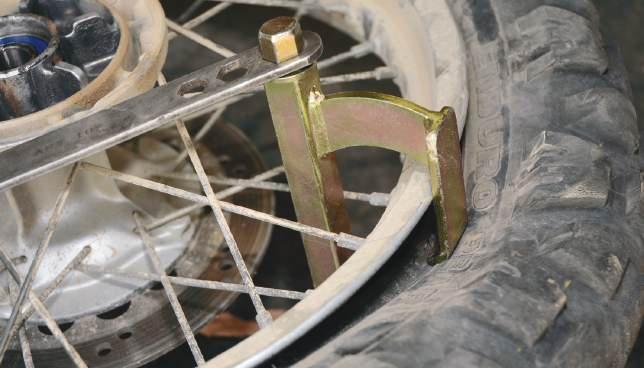
v Two rubber rim protectors
v One bottle of BeadGoop tyre-mounting lube
v One valve-stem multi-tool
v Instructions with beadbreaking and tyremounting tips.
Basically, the tyre levers pin together with the other components in the kit to form a frame with a captured lever, just like the manual tyre-changing machines people take to races or have in their sheds. Once assembled the wheel sits on the frame, a jaw is placed next to the rim and the operator can swing as much of his weight as he needs on the lever to depress the bead.

It’s very effective, tubed or tubeless, big wheel or small. Clunk! Down goes the bead. If it doesn’t, adjust the fulcrum points, or maybe eat a hamburger, and swing on it again.
Instructions with the kit are very thorough, and although it’s a bit fiddly, set up is logical and operation is easy. Once again, at 1.5kg it’s a bit heavier than we’d like to carry, and at $325 it’s a fair investment. But considering it could be left hanging up in the shed ready for general tyre changing, then dismantled and taken when needed, we can see where it’d work well. Also, once the bead

The Tyrepliers takes a little time because of the positioning and spanner winding, but it’s very effective, and we haven’t seen it beaten too often. It’s good equipment we wouldn’t like to be without, but even so, we don’t carry one on the bike. At 700gm it’s a chunk of metal, and seeing as we haven’t found any alternative use it’s just a tad heavier than we’d like to carry for a single-use tool that may not come out of the kit – hopefully – for months at a time. For a group travelling together and sharing the tool load, it’d be a must-have.
It’s standard equipment in the shed though, and there’ve been numerous occasions where we just couldn’t get a bead broken and some patience and the Tyrepliers did the job. That’s a heap better than heading down to the local bike shop or tyre place to ask for help.
The price currently listed on the Tyrepliers Bead Breaker is $82.50 plus postage. We think it’s good value.
is broken, the tyre levers which form part of the assembly can get to work removing the tyre. So the weight isn’t quite as drastic as it appears. Grab one from adventuremoto.com.au.
The models for tubed and tubeless have different valve-stem tools. Make sure you get the right one for your needs. If in doubt, get the tubed version. It’ll work for both.

Top right: It’s a little scary when all the bits tumble out of the BeadBrakR tool roll.
Right: The instructions included are good, and setting up is actually easy to follow and sensible.







Many brands of equipment available ph. 1300 883 908 info@adventuremotorcycle.com.au Fyshwick, Canberra



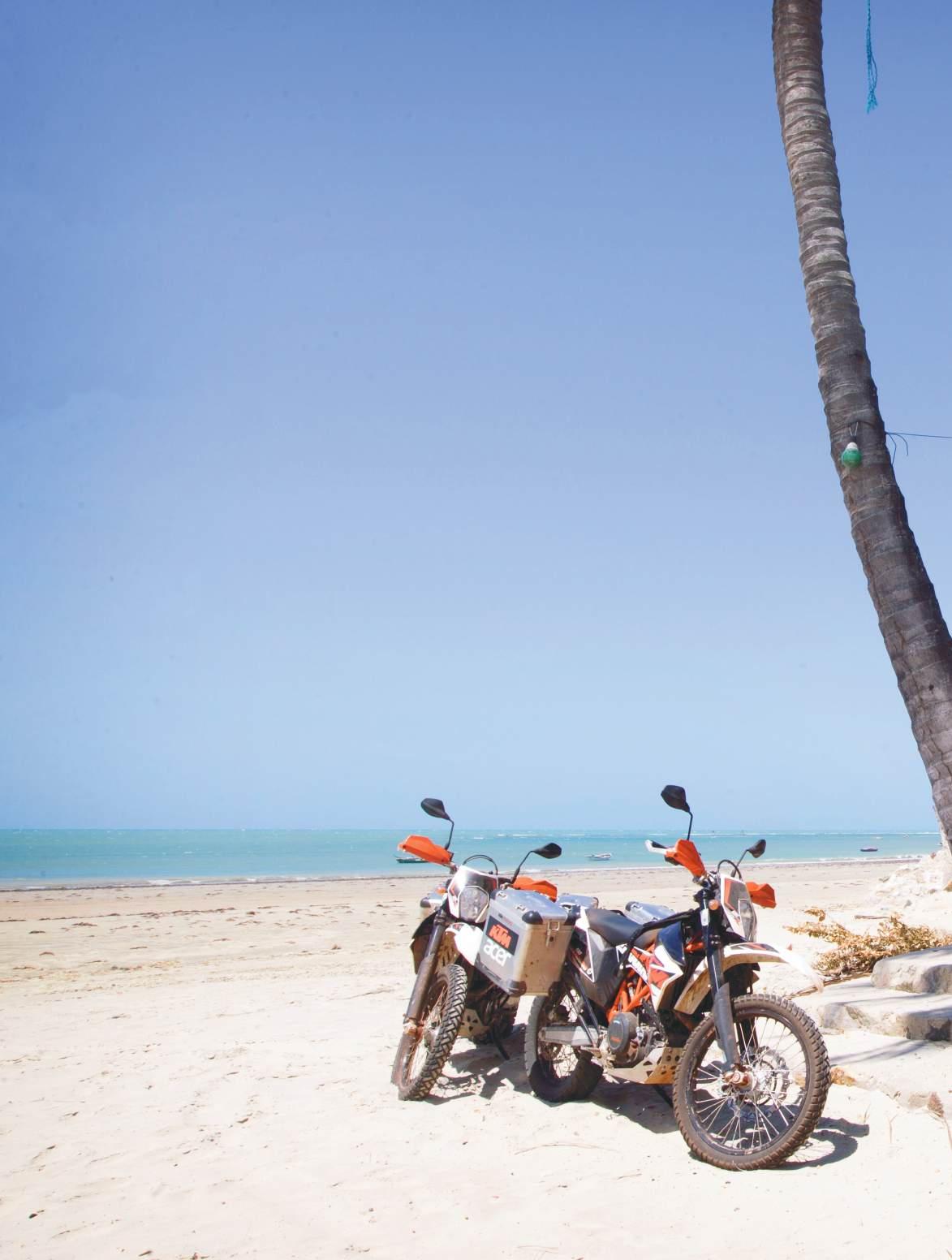
Last issue we left Irene and Lia running through the dunes of Barreirinhas in Brazil, planning to make their way to the hippy enclave of Jericoacoara. The story continues…

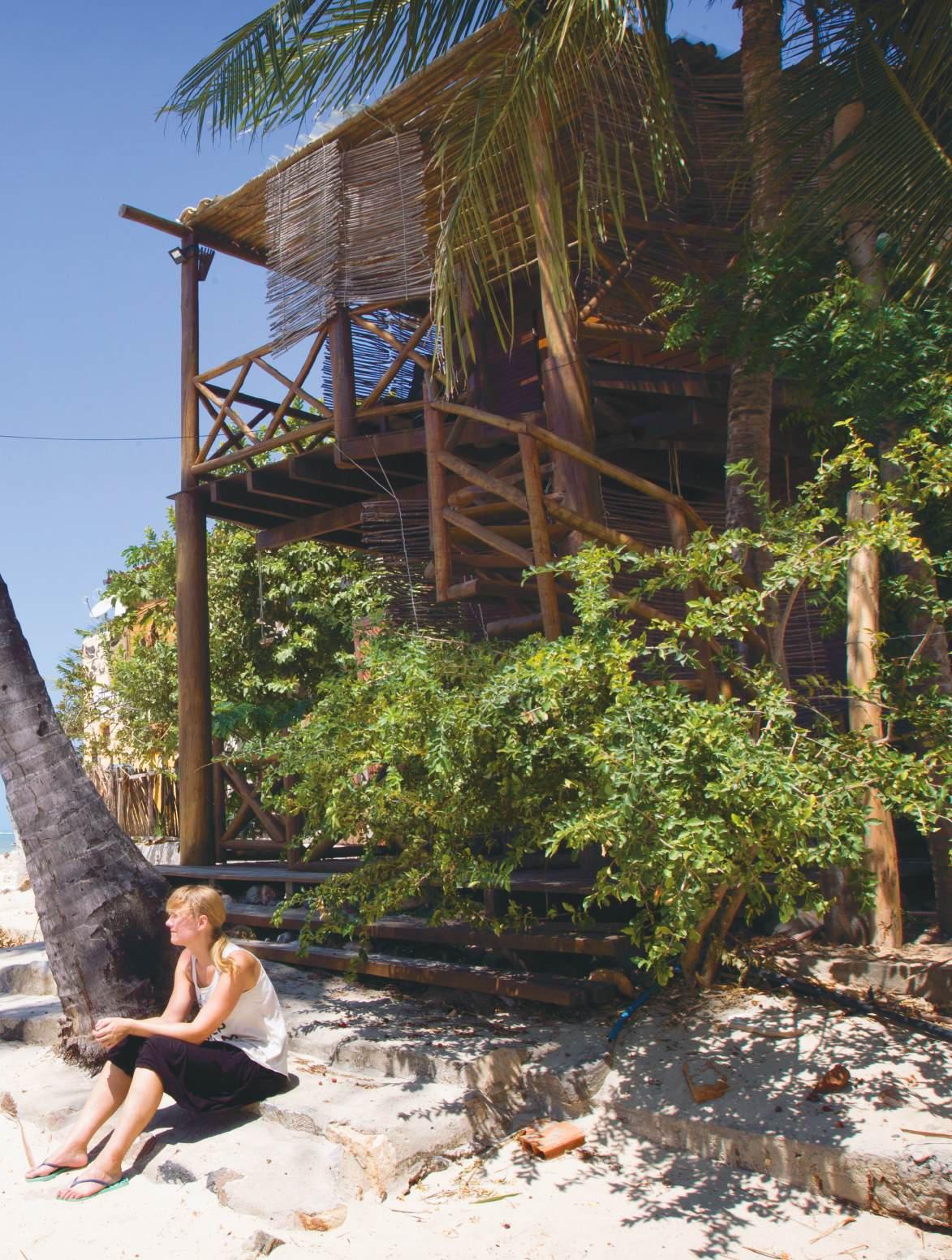
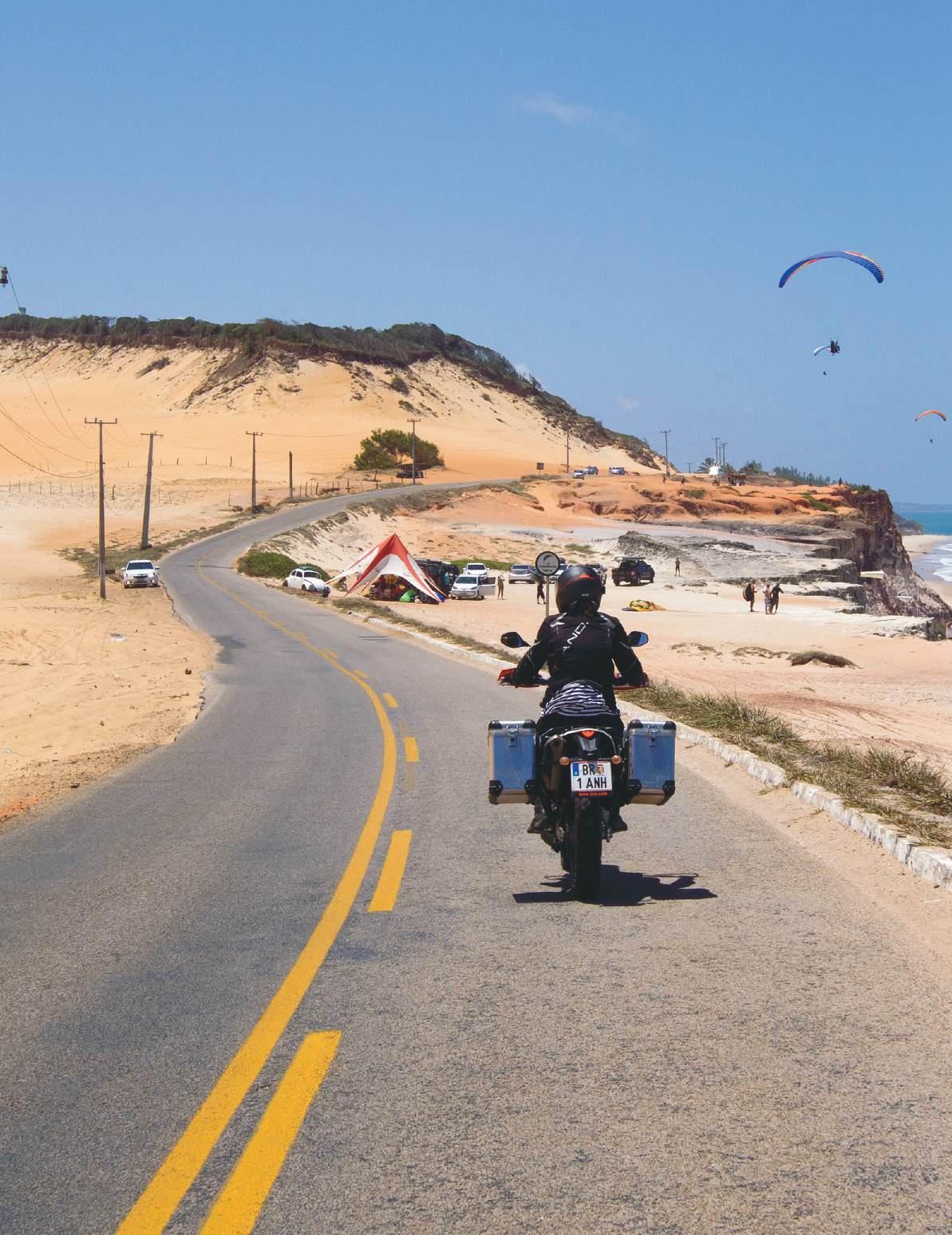

“Y
ou can park your motorcycles here and hire a jeep to go to Jeri.”
Astonished, I looked at the boys. Were they joking? Why wouldn’t we be able to ride the last part to Jeri on our KTMs?
The question was answered immediately: the sand was too deep and there was no road. Also, we were assured only local guides knew the route and without guides we’d get lost.
Not even for a moment did we consider leaving our bikes behind. Aside from anything else, the cost of renting a jeep was likely to be beyond us.
The boys insisted and convinced Lia, so I gave in and hired them. We deflated our tires in preparation for 60km of deep sand while our guides both piled on one very small-looking bike.
Dark night
Sweat flowed down my back and the

anxiety mounted as we battled along.
It was more than Lia could handle and she changed places with the pillion on the guides’ bike, electing to let him handle the KTM. He swabbed around like a fool and only just managed to keep her bike upright – which was better than could be said of my own riding. My style in the sand was similar to an aimless mop in the hands of a lazy cleaner. It was more falling off than falling down, but I couldn’t hold the bike upright and even got my foot stuck under a pannier. It was a hell that seemed to go on forever.
The guide on Lia’s bike saw I was having trouble and we exchanged bikes. Lia’s bike had less luggage and was lighter and that, at least, kept me going.
We arrived at a rickety bridge which was so ramshackle we decided to chance the water crossing instead, and that turned out to be a good decision.
The sand remained deep as the path narrowed and I watched the guide struggling to get my KTM through as the roost flew. Miraculously, I also managed to get through and stay upright. I continued sweating uncontrollably and suddenly the deep, loose sand became firmer. I didn’t dare allow a feeling of relief in case it was only a short section, but I was grateful for the respite.
We continued through the day and into the pitch dark of the night. After what seemed
Above: The Brazilians are an open, friendly and enthusiastic people. Below: On the orange sand master looking see what adventures Brazil had in store.
forever I was amazed to hear the surf of the Atlantic Ocean.
For the first time since the start of the hell ride I felt a moment of triumph. I allowed myself to enjoy the sound of the surf, despite the terror of riding more on intuition than on sight in the darkness.
The end came in sight at last. I could see all kinds of lights along the shore that could only be Jeri. Utterly broken but satisfied, I crawled off the bike.
After a few days of enjoying Jeri we pushed on and made another stop in Icarai de Amontada, a much quieter beach town. We acquired a beautiful treehouse right on the sand, underneath which we parked our 690s and from where it literally was a three-step stumble into the sea.
Once recovered from our ride through the sand we decided to have a look at Fortaleza with its city beach, boulevard and skyline of skyscrapers. It’s one of the many faces of Brazil. The big cities look

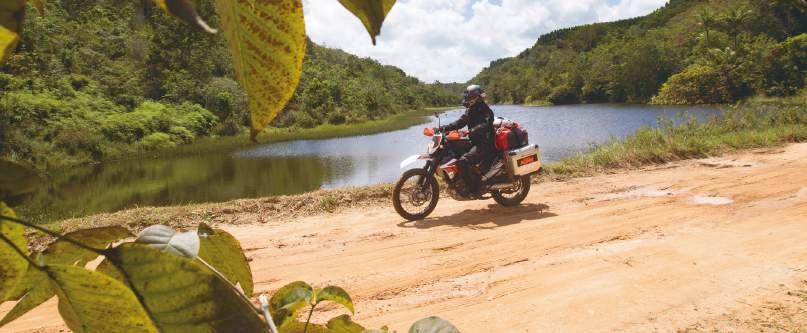
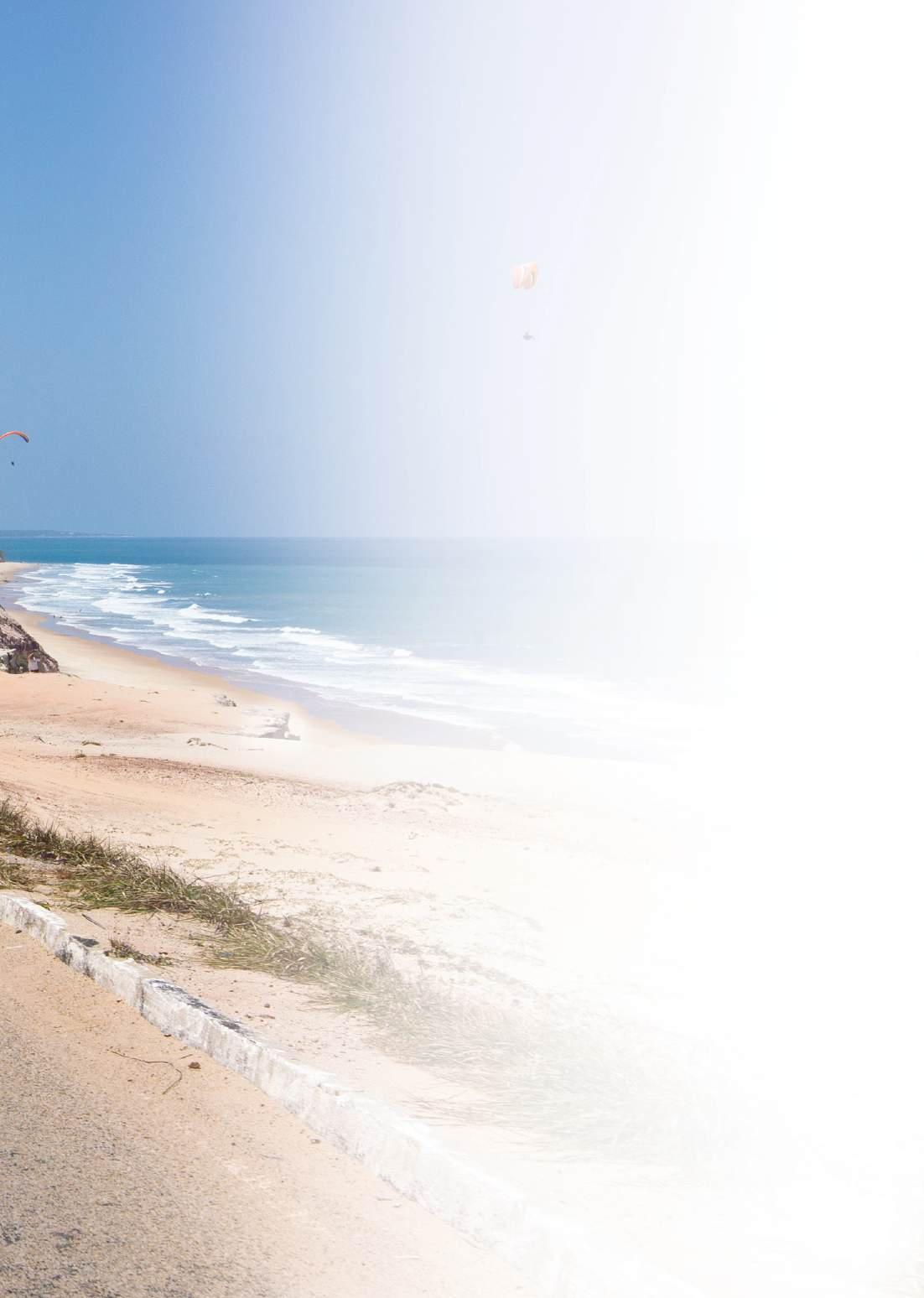

like a mixture of European and American variants, but riding into the city, with it’s population of over a million people, we passed communities indistinguishable from African villages. Brazil is a country of the utmost extremes.
Young men ran in shorts and singlets, elderly women power-walked in fluorescent leggings and children did fitness exercises in one of Fortaleza’s many public sports gardens. Our eyes were popping out of our heads. Everyone on the promenade walked in a sports outfit and we seriously wondered if this was a requirement for inhabitants of this city.

We couldn’t get enough of the different types of beautiful, pristine beaches with the unlikely, azure-coloured water of Brazil. Although the the treehouse hasn’t been beaten, we thought Praia de Pipa with its pink-tinted rock cliffs adjacent to the beach was even more idyllic.
And I haven’t mentioned the dolphins yet.
According to a French couple we met, dolphins could be seen every morning. Immediately after breakfast, I dived into the ocean and after drifting around for a while, four fins suddenly surfaced. I even looked straight into the eye of a dolphin right next to me when he poked his head through the water’s surface!
It was very exciting, because when you’re up so close they’re rather huge.
With a wide smile I climbed out of the sea. It was time to leave this breathtaking place behind and get back on our orange sand masters to see what more adventures Brazil had in store for us.
We left Praia de Pipa in a ferocious wind that nearly blew us off our bikes.
We chose to take a sand path along the beach instead of the regular road and just as we started the wind backed 180 degrees, the sun disappeared behind dark, threatening clouds, and in moments

it was raining cats and dogs. Sand is one thing, but ploughing through a huge pile of mud was something different. We decided to switch to the asphalt. Of course the rain stopped immediately. What a joy it was to be back on our KTM 690 Enduro Rs again after a few days sitting still. What great machines, both light and viable, but also real power beasts.
We’d planned to make Olinda our lunch stop, and according to the travel guide it was one of the most beautiful and well-preserved colonial cities in Brazil. The city was in Dutch hands in the 17th century and it was stunning. From the highest point above Olinda the panorama showed green in the foreground and in the background the coast and skyline of modern Recife.
A man approached and was sincerely moved we’d come to eat in his restaurant and travel through his city and country. He thanked us and wanted to know everything about us and our bikes and, of course, he wanted to take a picture. The Brazilians continued to amaze us. What an open, friendly and enthusiastic people they are!
After a few days we were on our way, heading to Chapada Diamantina, one of the most beautiful natural parks in Brazil. Departure Olinda wasn’t as easy as
Above: The last asphalt before heading off-road to Caraíva.
Left: Fortaleza with its city beach, boulevard and skyline of skyscrapers. u






Climate comfort chest, back and sleeve ventilation


SAS-TEC protectors at shoulder, elbow and knee

Removable sleeves

Removable breathable, wind and waterproof 3-layer membrane




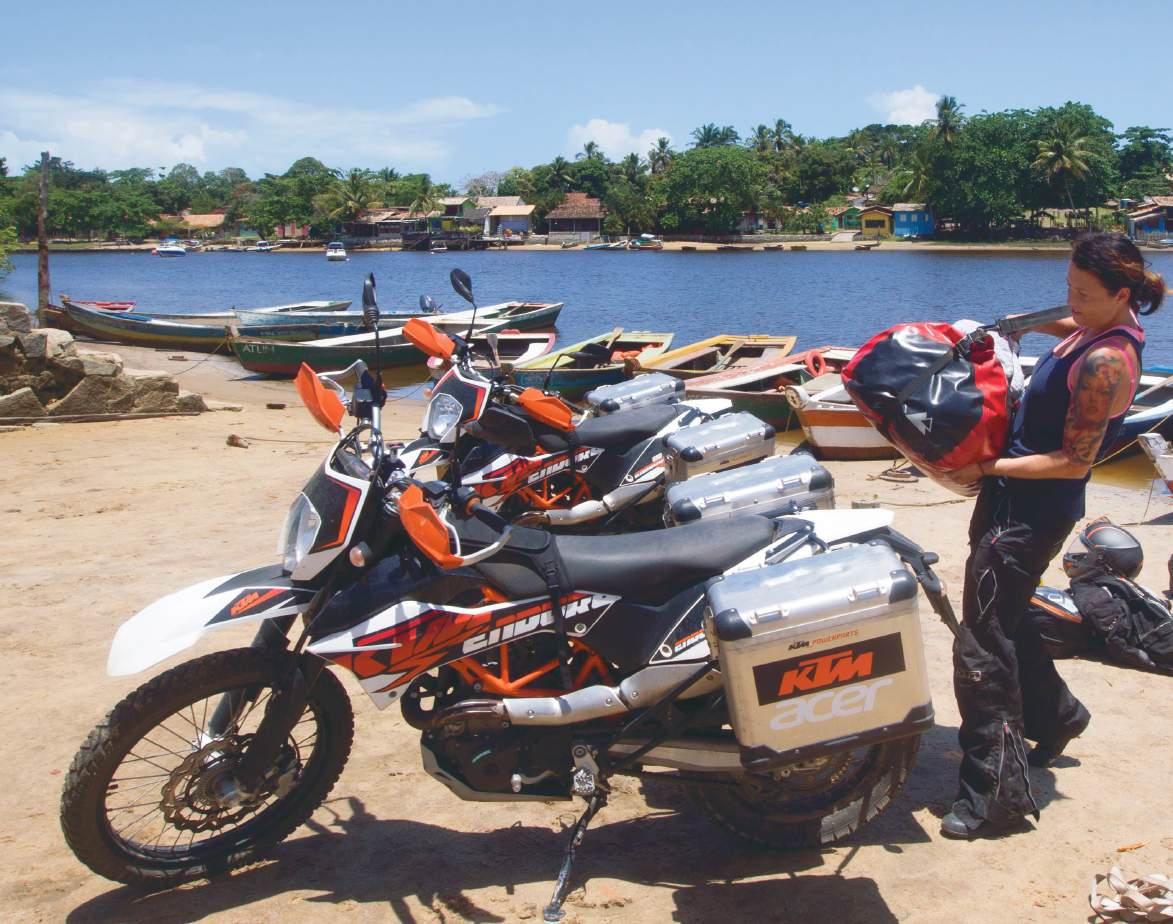

riding in. A very steep and long descent began our outbound route. The few cars that took the road did it at a creeping pace, brakes squealing the whole way. I took off downward at an uncontrollable speed, even with the throttle closed. I pumped the brakes but it hardly reduced my speed and the road seemed to descend for a very long time. My heart pounded loudly when I saw a blind crossing ahead. I tried to wash off speed, but managed to slow only a fraction. I hoped there would be no other traffic, because if there was I was screwed. A collision would be inevitable.
I hit the intersection to find it empty. What a relief!
I’d seen enough of Olinda. It was high time to leave it behind.
The next day we put in a long ride to cover as much distance as possible, passing through rolling green hills of sugarcane. The sunlight shone through
was idyllic.
Right: Two different ways of getting around.
the cane and turned it even greener.
The landscape changed.
The turquoise-coloured sea shone through the numerous tall palm trees. It was the ‘Gold Coast’ of the country and one resort followed the other. Seeing sea turtles was high on our wish list, preferably in the wild, but we were given a tip to go to Praia do Forte where Projeto Tamar is located, a nonprofit organization that annually hatches 500,000 baby turtles and helps to recover injured adult species and sets them free.
As soon as we approached Projeto Tamar we were overcome with a ‘Disney


World’ feeling. We wouldn’t have been surprised if suddenly a life-sized equivalent of Mickey Mouse in a turtle outfit had jumped in front of us. Although it’s a fine initiative and it’s thanks to them we can enjoy the animals, we were left with the feeling the large sea creatures swim in pools which are far too small. It was hard to accept when the immense Atlantic Ocean was just a few metres away.
Our trip continued along a winding coastal route through the Atlantic rainforest to Salvador, a city where everything is about music and dance.
We enjoyed the live music on the streets and tried the local specialty, acarajé (fried beans with shrimp balls), but it wasn’t our favourite. That honour went to the purple açai ice cream we combined with honey, banana and muesli.
Chapada Diamantina was a 400km ride which we managed in one day, and where we booked a tour which consisted of climbing a mountain top, scrambling between rocks and river beds, and taking a cave trip where we snorkeled in u


clear blue water in the pitch dark. It was gorgeous. We could’ve stayed for weeks doing countless walks, but we moved on quickly, hoping to see migratory whales.
After a lovely, curved, coastal road of reasonable asphalt we hit the highway and headed for Caravelas, the whale-watching base. Unfortunately, October was just too late in the season so we decided to keep moving.
The evening set in as we rode a narrow sand path over small hills to the beach village of Caraíva. The hills kept on following each other and the path became steeper and narrower. Just as I wondered if we were heading in the right direction, I saw a hand-crafted signpost that took away my doubt. In the ink-dark I changed from low beam to high beam continuously. The hard, red sand changed to a loose, white variety which, fortunately, was very manageable on our orange sand masters.
After 60km we ended up in a parking
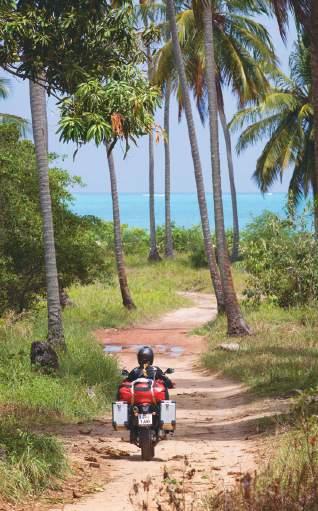
Brazil is the largest country in both South America and Latin America. As the world’s fifth-largest country by both area and population, it’s the largest country to have Portuguese as an official language and the only one in the Americas.
Bounded by the Atlantic Ocean on the east, Brazil has a coastline of 7500km. It borders all other South American countries except Ecuador and Chile and covers 47.3 per cent of the continent’s land area. Its Amazon River basin includes a vast tropical forest, home to diverse wildlife, a variety of ecological systems, and extensive natural resources spanning numerous protected habitats. This unique environmental heritage makes Brazil one of 17 megadiverse countries, and is the subject of significant global interest and debate regarding deforestation and environmental protection. In the Amazon forest there still live undiscovered Indian tribes. Portugal claimed Brazil as a colony to its empire in 1500, but nowadays Brazil is an independent republic with the world’s eighthlargest economy.
lot where we left our KTMs to cross a river and go where no motor vehicles were allowed: Caraíva.
Via Leandro, who we met in our hostel, put us in touch with the Pataxó Indians. We stayed with them overnight and even saw a ritual campfire. With painted faces and bodies, clothed in wicker skirts and headdresses, the Pataxó danced around the fire and it was an unforgettable experience.
Future issues will follow The Riding Reporters as their journey across South America continues. To stay in touch with Irene and her travels, search irenewouters. ridingreporters on Facebook or Instagram.


Above: Brazil is a country of contrasts. The big cities look like a mixture of European and American variants, but the outskirts are ringed with communities indistinguishable from African villages.
Left: A narrow sand path to Maragogi on Brazil’s ‘Gold Coast’.
Only a few of the more than 4000 airports in Brazil provide international flights. São Paulo and Rio de Janeiro are the main two, but Belo Horizonte, Brasília, Recife, Natal, and Fortaleza are also possibilities. You can also opt to enter overland via a bordering country.
Overnight lodgings and food are readily available along the route, including both privately owned and national chains. You can even lodge at hotels at the numerous gas stations.
Brazil has 1,751,868km of roads, and 94.5 per cent are unpaved. Nonetheless you can often choose paved roads to get to your destination, including excellent six-lane highways. You have to pay toll as a motorcyclist for highways in some parts of Brazil, like in Rio de Janeiro for example.






Adventure Rider Magazine went for the SWM Superdual in big way last issue. For 2018 it looks as though the bar has been raised. Whenever anyone mentions a bar SWM’s irrepressible Stephen Tuff is sure to be nearby. Here’s the inside scoop on the new bikes.

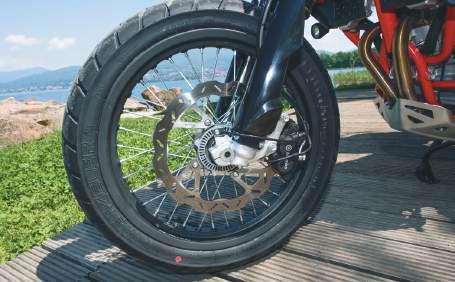
SAbove: Metzeler Tourances are supplied stock on both models. Right: The panniers are schmicko units.
the factory-fitted 18/21 wheel combo and accessory pack everyone’s been talking about.
The 2017 Superdual arrived on Aussie roads to an extremely warm reception. The 600cc donk brought smiles to the faces of all who embraced the Husqvarna TE630 from 2012. Unless you’ve been living inside your man cave with no new bike info for the past 18 months, you should already know SWM – the Italian enduro manufacturer from the 1970s to early ’80s – is back in business in the former Husqvarna factory in Biandronno. That’s the same factory owned and re-vamped by BMW just a few years ago.

switchable ABS in compliance with Euro4 standards and are Learner Approved Motorcycle Scheme (LAMS) approved.
The other great inclusion for the 2018 Superdual is the arrival of the 18/21-inch wheel combination. It’s ideal for riders who prefer to spend the majority of their riding time in the dirt.
X to a T
If you have, in fact, just emerged from that man cave from an extended stay, you’ll no doubt be keen for a ride to clear your head, because the news that Trump is President Of The World will have you dazed and confused. Luckily for you the two new SWM Superdual models arrive in Australia in December 2017. They’re probably on the floor in your local SWM dealer already.
So prepare to make adventure riding great again.
The 2017 model is a mighty fine machine with a 17/19-inch wheel combo that’s capable on- and off-road, and has no ABS. Also, the 2017 model was off limits for learner riders or riders holding a restricted licence.
The 2018 SWM Superdual X comes with 18/21-inch wheels while the
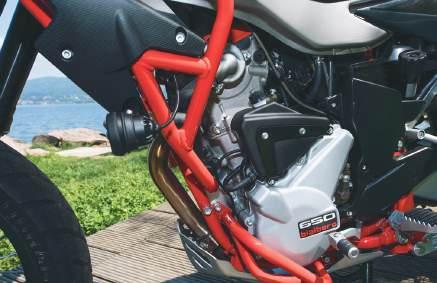
Above: Red crash bars and frame make the SWM an eye-catcher.
Below left: The dip switch for high- and low-beam is a separate fitting. Must be a Euro thing.
WM’s Superdual has created a storm in the adventure-riding coffee cup. The competitively priced Italian has added some spice to the single-cylinder adventure segment and now has added a big sweetener. In addition to the bike Adventure Rider Magazine enjoyed so much last issue, the 2018 SWM Superdual brings to life
The 2018 models will be supplied with

Below: Nice and simple. Excellent.
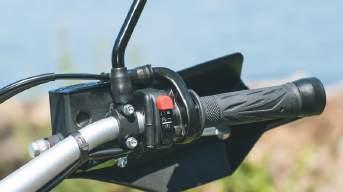
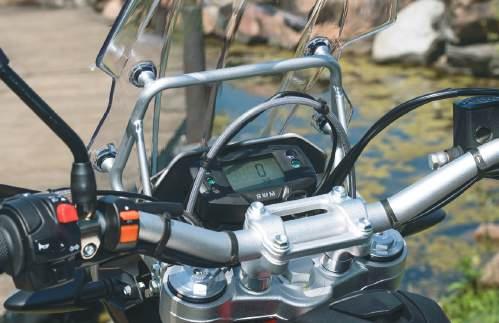

Above: The same uncluttered dash as 2017.
There’s plenty of info on the LCD screen.
Left: Rubber inserts in the footpegs are easy to remove for off-road terrain.
Superdual T has the 17/19-inch wheel set-up.
The X model is eye-catching in a red/black/white colour scheme while the T model is available in grey/black.
Both models sport black rims, red frame and red crash bars. Both bikes have a tough, adventure-bike attitude.
The X model seat is scalloped in comparison to the T model to keep the same seat height of 898mm. The sidestand and centrestand on the X model are longer for the obvious increase in distance between earth and bike from the larger wheel set.
Hand guards, windscreen and Metzeler Tourance tyres are standard equipment on both the X and T models.
Sharp
Warranty is generous at 24 months or 20,000km (whichever comes first) and perhaps best of all, the price is still mighty fine at $10,490 recommended retail including GST, plus on-road costs. That’s a minimal increase of just $500 over the 2017 model.
To celebrate the introduction of the 2018 SWM Superdual, SWM Australia is offering a free GT Kit (panniers and LED lights) valued at $1500, for all orders placed before February 28, 2018.

Web: www.swmmotorcycles.com.au
Recommended retail: $10,490.00 plus ORC including 24 months or 20,000km parts and labour warranty.
Engine: Liquid-cooled, DOHC, four-valve, single-cylinder four-stoke
Capacity: 600cc
Bore x Stroke: 100mm x 76.4mm
Transmission: Six-speed
Clutch: Wet multi-plate with hydraulic control
Ignition: GET
Fuel system: Mikuni D45 EFI
Start: Electric
Front suspension: 45mm USD Fast Ace fork with 210mm of travel
Rear suspension: Fully adjustable Sachs shock with external shock spring pre-load adjuster and 270mm of travel
Front wheel: 19-inch (T model) 21-inch (X model) with 300mm brake disc
Rear wheel: 17-inch (T model) 18-inch (X model) with 220mm brake disc
Seat Height: 890mm
Wheelbase: 1510mm
Ground clearance: 180mm
Fuel capacity: 18 litres
Weight: 169kg

Below: A scalloped seat on the X model means seat heights are the same on both models, despite the different wheel sizes.
Right: Plenty of capacity in the panniers.




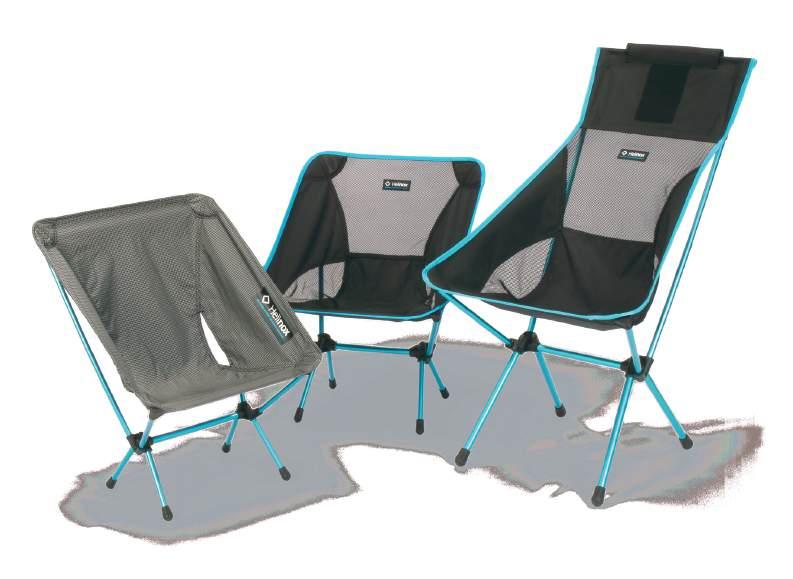
Five years ago Helinox revolutionised campsite comfort with Chair One Engineered using the world’s lightest & strongest alloy tubing, premium materials and super-strong nylon hubs, Chair One is the original award-winning icon of lightweight chair design.
The Helinox range has now grown to include more chairs, tables and stretchers.
All built to the same high standard with a 5 year warranty. Reward yourself with quality – choose Helinox.






Ian Bowden gets a Dusty Butt after a decade of trying.
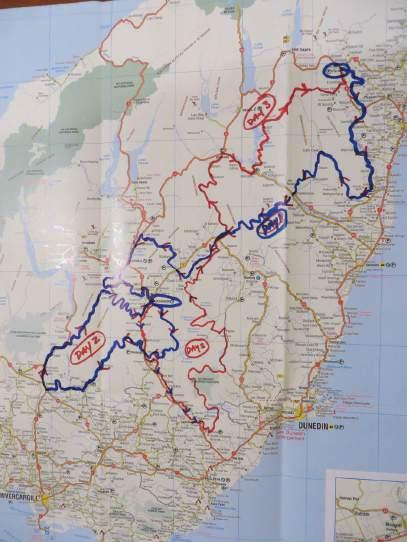

I’ve been trying to get to the annual Dusty Butt ride for the last 10 years, but circumstances have always got in the way. This year I’d just returned from working overseas when I checked the internet to find the ride was on in two weeks and all 150 positions were filled. Bugger! It looked like I’d missed out again.
A week later at a local trail ride a friend mentioned he’d entered the Dusty Butt but couldn’t make it.

He suggested I should take his place. That got the mind into gear. I live in the top half of the North Island and the ride was in the central South Island. Was it possible to make all the arrangements and get there at such short notice?
‘Hell yeah!’ I decided. It was doable – just.
Ride fever clicked into overdrive and with just two days to departure I got busy planning. The bike needed prepping, gear needed packing, ferries had to be booked and accommodation to be organised. Oh. And permission from the wife, of course. Hadn’t I said that?
I did it all and managed to leave on time.
Rain was forecast for the departure day and was I looking forward to riding my DR650 with new tyres for 500km on boring highways to board the Cook Strait Ferry? Hell, no.
My sensible wife said, “Why don’t you trailer your bike down to Wellington, stay overnight at Pete’s place and catch the ferry the next morning? That way you won’t get a wet arse?”
I didn’t need much persuasion. I loaded the bike onto the trailer, hopped in the fourbee and cranked up the heater, blue-toothed my iPhone for music and headed south in absolute comfort. Oh yeah. I kissed the wife as I left.
The Kriega Dusty Butt, often called the ‘DB1.4K’ consists of
approximately 1400km of on- and off-road riding over three days. It crosses through remote sections of NZ’s south island offering absolutely spectacular scenery, but it’s important to keep in mind it’s no dawdle in the park – nor even a typical trail or road ride. Riders must conquer a 1400km route that’s physically and mentally draining and requires up to 14 hours of riding each day, depending on riding skill and the number of stops taken.
The ride isn’t intended for the faint-hearted, but it’s an epic adventure like no other. Optional challenge sections offer the competent off-road rider some seriously challenging and fun terrain to sink their teeth into and should only be tackled by riders with good off-road skills. The route includes terrain that challenges bike-control skills over extended rough, steep, rutted, or rocky tracks, deep bogs and multiple stream and river crossings. These sections will also challenge riders’ fortitude as they navigate tracks past very high, steep slopes and bluffs.
And riders need to be prepared for snow, even in February.
I’d taken some great deviations through the back country before arriving at Fairlie to the start at the packed Gladstone Hotel bar. A big buffet dinner, sign in, ride packs and a briefing all ran in due course. I’d come alone, and as it was a requirement to ride in pairs or groups for safety and support I teamed up with three other solo riders.
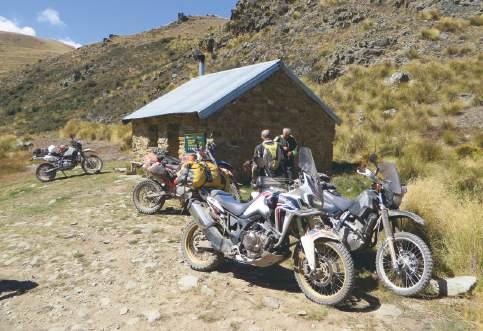
It was great finding out over a beer that Mike, our youngest team member, was a doctor. How good’s that? Your own doctor on the scene if you have an off.
Our team of four consisted of myself from Tauranga on a DR650, team doctor Mike who’d ridden a KTM350EXC from Auckland, Hamish from Hawkes Bay on a new Africa Twin and Kevin from Christchurch on another DR650.
Dusty plus
The next morning I woke to the sound of bikes riding out of town, in the dark, at 6:00am.
And I’d thought I was keen.
After a quick breakfast I loaded up and met the others at 7:00am. It was a beautiful, fine, clear day and the forecast was for the next week to be the same. With the route loaded on the GPS we were off, straight into a cold river crossing on the outskirts of town.
It wasn’t long before I figured out how the event got its name – it was bloody dusty. I’ve done plenty of riding on the South Island, but mostly with small groups and usually with me leading the way, so I’ve been the dust maker more than the dust taker.
After a relatively easy 115km we passed through Waimate, choosing not to fuel up as we all had plenty for the next 100km section. Soon after leaving Waimate we charged into a private forest with fantastic trails that led onto greater farm
u
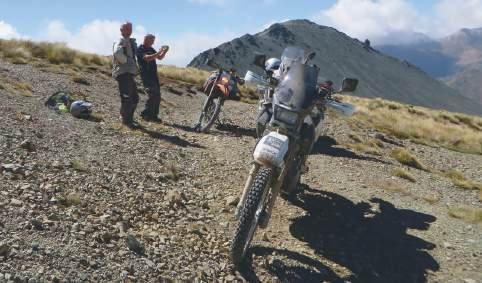













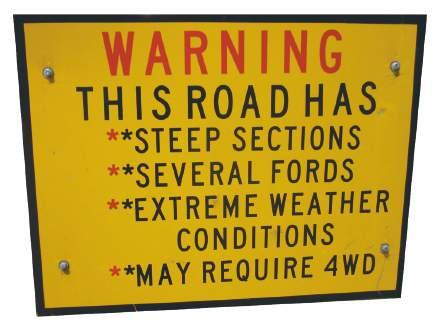
trails through the hilly back country. It was great riding and the only trouble was my older technology GPS was confusing, giving me options at many of the intersections rather than the planned, loaded route. After going the wrong way a couple of times and losing touch with my teammates I opted to follow rather than lead. Their GPS units were working better than mine.
After food, fuel and a GPS reboot at Kurow we hit the first challenge section. The four of us had agreed to do these and help each other if any difficulties arose.
Well, the climb up the Awakino ski field track was no walk in the park. Steep and rocky, it sure was a challenge. My heart rate was well up when I reached the top with sweat pouring down my face, but the views and the crisp mountain air made it all the more worthwhile. We’d passed quite a few bikes on the ascent, including one chap who burnt out the clutch on his DR.
After more rock hopping and scenic overload we descended the Ida Valley to Omakau. That section was a long 160km, so a fuel top up, pie and energy drink were required to keep bike and body moving forward for the remaining 140km.
Four tired, dirty and thirsty boys rode into Alexandra at 7:00pm. We’d taken 12 hours to complete the first day, and we slept and snored well that night.
We were up and riding by 7:00am the following day, and the route kicked off with a speedway-sliders’ dream road. Hamish was up front on the big Africa Twin and leaving big slash marks for
Left: Start of the Nevis Road.
Below: Author Ian having a breather at the top of the Awakino ski field climb. Right: The top of the Old Man Range.

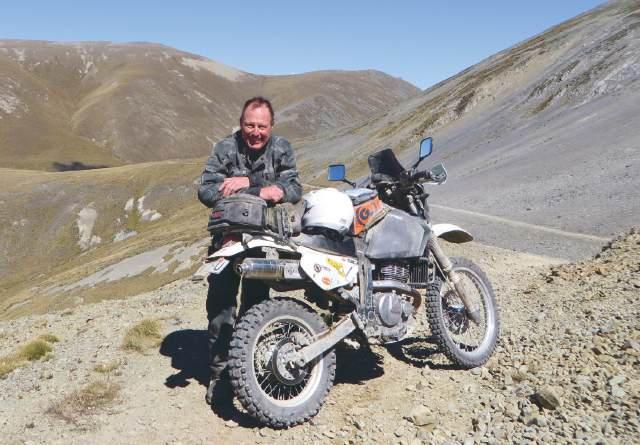
everyone else to follow. When we pulled up the grins were stretching from ear to ear.
Next it was on to private farmland with a few grassy ruts that still had the previous night’s dew present, and this caught out Doctor Mike who went down rather hard. Fortunately he wasn’t hurt bad, but was heard muttering, “I treat people who do this all the time, I should know better.”
Ha! He did know better: he was out there doing it with us.
Piano play
Passing through Roxburgh mid-morning after more picture-perfect Otago
countryside, we had a quick team talk before tackling the infamous Piano Flat challenge section.
We’d agreed to keep each other in sight. It would be impossible for Hamish alone to extract the big twin if he got stuck in one of the many bogs. Luckily it hadn’t rained for a few days so the bogs weren’t full, but it still took skill and cunning to stay on track. With only one minor case-out that had to be photographed before an easy extraction, this section proved well worth doing.
Taking the time for a decent coffee and sit-down lunch in Lumsden after refuelling gave the body time to revitalise.
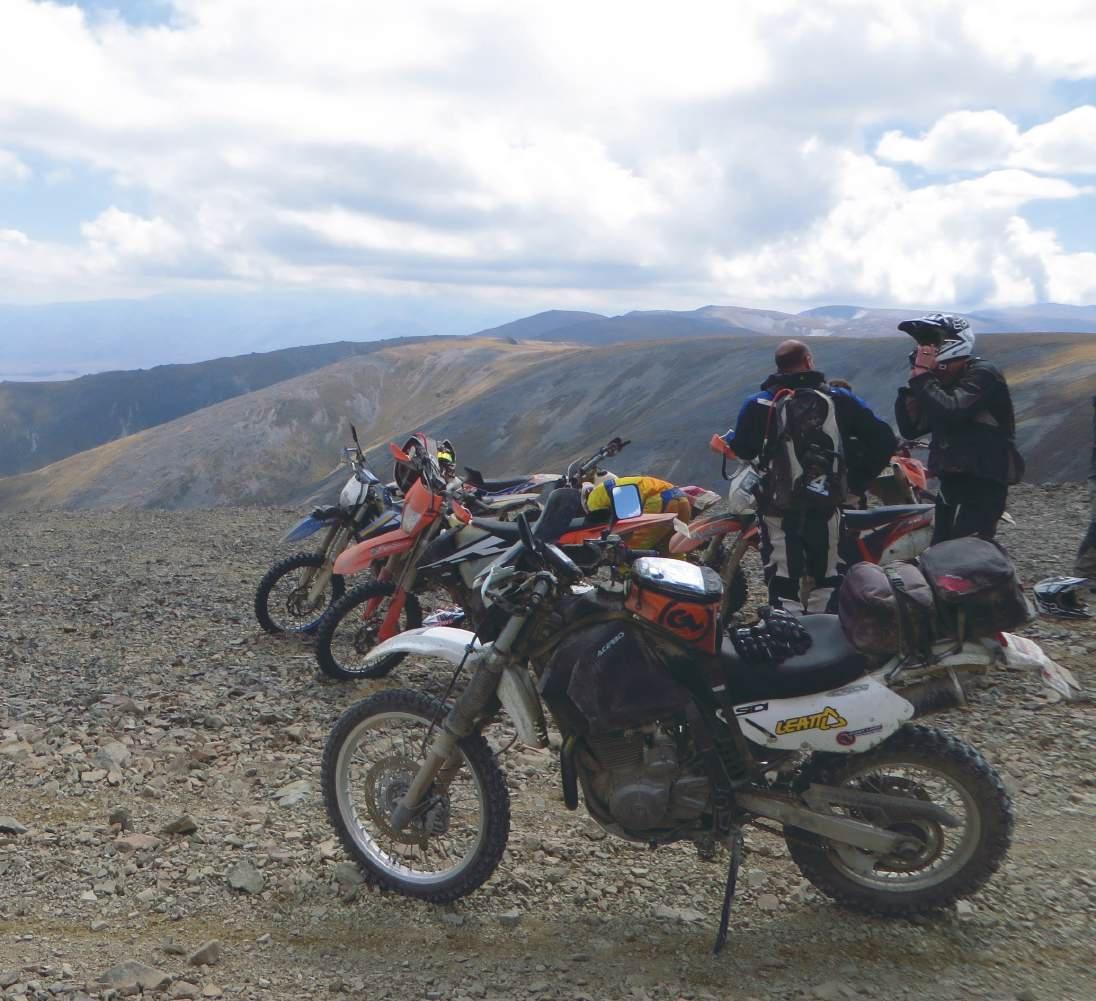

There was a bit of blacktop before turning off for the Nevis section, an excellent ride with its many river crossings and fast trails. That section would have to rate very high on the excite-o-meter.
Just before the Nevis Saddle we turned right into the Old Man and Old Woman Ranges. I hadn’t ridden through these ranges before, and what a bonus!
town and a lot of bikes had to refuel for the next, long, 280km section to Omarama, so there was a delay.
We then headed into the Lammerlaw and Lammermoor Ranges, firstly through a pine forest, then onto the tussock lands. This led to the Dunstan trails and the challenge section to the Old Serpentine Church with its big holes and washouts. Care was required not to drop into something that would require a helicopter for extraction.
We road on past the Poolburn Reservoir heading north and crossed the main road into the Hawkdun Ranges.

The trails were some of the best and fastest we’d done. It was a real fun blast and the views as we descended the mountains to Roxburgh were magnificent.
What a day. We rode into Alexandra at 5:00pm to log the shortest of the three days’ riding.
A cool cruise down the blacktop started the third day as we headed to Lawrence.
Apart from a sunstrike problem on the dusty hill sections getting to the Lawrence servo, all went well.
There’s only one card servo in this small
This was big country with massive river valleys. Again we took the challengesection option, staying in the valley with its many tricky river crossings.
Unfortunately Doctor Mike slipped on the rocks in one of the crossings. He had the sense to shut down as the bike went over and conveniently lay under the bike in the cold water to stop the motor filling with water. It was unintended I think – but very effective. We didn’t have to carry out a dewatering job after lifting it off him.
“Don’t worry, Doc,” we reassured him. “We wouldn’t have let you drown unless

you’d let water get into that motor!” Food and fuel was a welcome sight when we finally arrived at Omarama. It was a long 280km and bikes and bodies were running on empty.
After leaving Omarama enroute to Black Forest Station, the police had stopped all traffic due to a scrub fire near the road. We watched as helicopters with monsoon buckets doused it down and after 45 minutes they let us through. This delay meant a big group bunched up when we arrived at the station, resulting in a bit of a sprint to try for the front to stay out of the dust cloud. Hamish and I won this sprint with some rather spirited riding and quick gate opening and closing.
Main: Piano Flat Trail.
Below left: Black Forest Station Trail.
Below: What three days of spirited riding did to a new tyre on the DR.
Top right: Hamish with the big Africa Twin cased out on Piano Flat.
Below right: Enjoying the view over the Umbrella Mountains.


After the station, which was another excellent ride, we rode over McKenzie’s Pass, finally arriving back in Fairlie, dusty, parched and knackered!
Man. Cold beers never tasted so good.
Done and dusted
What a ride. 1400km of South Island high country takes a lot out of you over three days.

I’d have to say it’s the longest three days of riding I’ve encountered, but also among the best. I’ve only put the highlights in this story as there was far too much riding to document it all, and I now see why so many return year after year from around the country, and why the keenest of adventure riders were together in the one place. It’s a great ride and I’d love to return when circumstances allow.
I’ll be working on those circumstances.
A final word from my wife: “I’ve got circumstances around the house you may want to work on!”
What can I say? “Coming dear!”
Many thanks to Gordon and Clair of Epic Adventures who are now the organisers of this great annual ride. It’s absolutely fantastic and long may it last.



These glasses are the solution for those of you who can see clearly out front, but struggle to see your INSTRUMENT console. IC Nearviews are riding glasses with bifocal lenses. Available in: +1.0, +1.5, +2.0, +2.5 & +3.0.


» Lightweight Frames » Anti-Fog Coating » Super Flexible SMOKE
Very flat arms to fit comfortably inside your helmet.
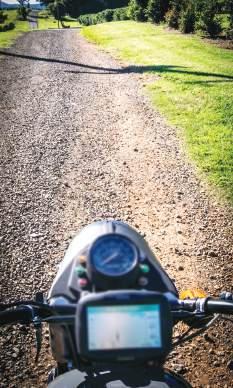

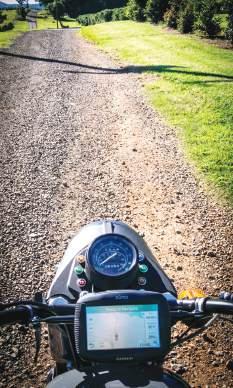
Positive Dust Seal (optional extra)
This dust seal clips in and out of the IC Nearviews frames and protects your eyes from fine dust, pollen and other irritants as well as peripheral light.
Unfog your glasses easily BEFORE you ride. This little gem gives you around 70 applications and keeps your glasses FOG-FREE for a long time, so you can enjoy your ride safely.





The eighth running of the Scrapheap Adventure Ride hit Inverell in NSW like several tonnes of clapped-out, hand-built, recycled machinery. We’ve never seen such a happy crew.
few years back Perry Gilsenan had an idea for a ride to raise funds for charity group Down Syndrome NSW.
Perry – ‘Pezz’ to those who know him – thought people would love to build bikes and ride them to a destination. He set a few guidelines on what sort of bikes could be used, and those guidelines made the build and ride a challenge.
The Australian riding community answered the call.
Over the years riders, complete with all the tools and spares they could carry, organised sponsorship to see them pilot their unlikely scrapheaps to places like Cameron Corner, Lake Urana, Nymboida, and Bourke among others. We’ve seen some unlikely machinery do the business, including a sidecar made from a rainwater tank and bikes with so much character it’s
70 advridermag.com.au
hard to tell what they were to start with.
Perry himself has a reputation for some out-there builds, and in this company, that’s not an easy reputation to earn.
For 2017 110 riders registered, around $80,000 was raised and the destination was Green Valley Farm, Tingha – a destination familiar to readers of Adventure Rider Magazine
We caught up with Sydney-based Perry, 54, and asked him how things were going.
“This has been our largest number of rider registrations yet,” beamed Pezz. He’s always beaming. “We had 200 at the presentation dinner, and with the donations from 2017 we’ve raised over $500,000 for Down Syndrome NSW now.
“We have so much engagement with the community. The Up Club, a Down Syndrome club based in Sydney, came up
Above left: Tim Allen’s DT175 with Husky WR125 Marzocchi Forks. Scrapper extraordinaire!
Top right: There’s some wild builds done for the Scrapheap.
Above right: Perry Gilsenan thought people would love to build bikes and ride them to a destination. He was right! Down Syndrome NSW is about $500,000 better off thanks to these guys.
and did raffle tickets and welcomed people. They have an air-raid siren they sound every time someone comes in.
“Green Valley Farm has been fantastic, and it’s been very, very good.”
If you’re keen to build a bike and take the Scrapheap Challenge, log on to scrapheapadventureride.com.au to see what it’s all about.
We doubt you’ll find a more supportive or fun group with than this lot.


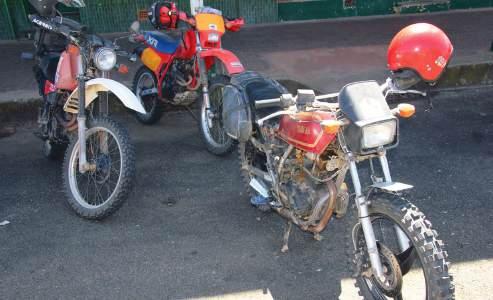
Top: Green Valley Farm was a fabulous venue, as always.
Above: Lee Slade’s China Bike called ‘The Tea Bag’.
Below left: It’s like a Distinguished Gentleman’s Ride, but the dress standards aren’t as tough.
Below right: John Samuel’s XLV750 has done a few Scrapheaps and has the souvenirs to prove it.
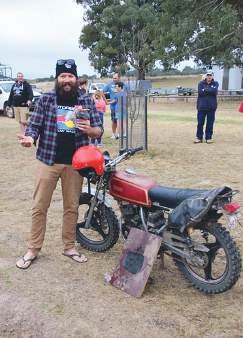

It takes support from great people to make a phenomenon like the Scrapheap Adventure Ride happen, and while the riders are all generous and giving, there’s a group of companies offering big support as well. Next time you’re looking for products, remember these guys:
R Hare And Forbes Machinery House
R Adventure Moto
R Cameron Damon Media
R Signandbadge.com.au
R Motohub Motorcycles
R Sydney Laser Welding
R Matters Financial Solutions



When Ryan Heath said he was going to Kyrgyzstan there was an assumption any place whose name ended with ‘stan’ wasn’t a travel destination of choice. It just shows how wrong assumptions can be.



Formally part of the Soviet Union, Kyrgyzstan gained its independence in 1991. It’s a small, landlocked nation that forms part of the Silk Road and it’s absolutely spectacular –6500m snow-capped peaks, blue alpine lakes, lush green valleys dotted with yurts, glacier-fed streams and welcoming locals.
Travel bookshops aren’t bursting with Kyrgyzstan books or city destination guides to Bishkek or Osh, but despite its non-existent reputation, it’s where Mick McDonald and I found ourselves, ready for a 14-day motorcycle tour in Central Asia. Mick, Compass Expeditions’ founder, was lead rider and I was lucky enough to be in charge of one of the support vehicles.
Our starting location was Osh, Kyrgyzstan’s second city, sitting in the lush Ferghana Valley. Given the country is largely mountainous, the Ferghana Valley is the country’s breadbasket.
Main: A Compass Expeditions tour of Kyrgyzstan is a special experience.
u
Insert: A great group set out on Compass Expeditions’ 14-day tour of Kyrgyzstan. Riders were lucky enough to experience home stay and yurt accommodation, giving a genuine presentation of Kyrgyzstan lifestyle and culture.
Below: XT600s and 660 Ténérés were perfect bikes for the rugged conditions.


It also boasts one of the largest bazaars in Central Asia.
Gosh. Osh
The first day of the tour saw us introducing the riders to the XT600s and 660 Ténérés, perfect bikes for the rugged conditions, and heading southeast towards the Tajikistan border. Early in the day the ascent to the 2389m peak of Chyyrchyk Pass had everyone greeted by smiling locals who were happy to pose for photos. From there we dropped down into the valley and through the town of Gulcha, stopping beside a raging, glacierfed river to enjoy our first Compass lunch, transported to the spot in the support vehicles.
After the sedate nature of the pavement the return trip to Osh was strictly dirt, alongside the Kurshab River through incredible canyons and along twisting paths. The amazing scenery unfolded as we crossed narrow bridges over the raging torrent below. Slowly the canyon widened into the fertile Ferghana Valley and we were back in Osh to complete a great first day.
The next day kicked off with early Osh-city traffic chaos as the group left the city and climbed towards Jalal-Abad.
After the liberal traffic rules and bitumen of the city it was all dirt riding for an afternoon of unparalleled beauty,

including climbing the 3000m Kaldama Pass via a series of switchbacks overlooking green summer pastures surrounded by snow-capped peaks. The heat and traffic chaos of the morning seemed a world away. It was as if we were the only people in the world as we slowly snaked our way to the top. From the support vehicle it was a fantastic panorama of 14 motorcycles, strung out like beads on a string, twisting up the rocky path to the summit. The views from the top were breathtaking – and not just because of the altitude.
A taste of Kyrgyz hospitality greeted us for the overnight home stay in Kazarman. The host, Baktygul, provided warm beds and a fine local meal, giving the group a rare glimpse of a real family and a real home, rather than the common, same-inevery-city hotel room.
The next day continued to set the bar high for jaw-dropping scenery.
After breakfast we climbed a 2600m pass and spent most of the day at 2000m, crossing another 2800m pass in the afternoon. It was twisties for most of the day, with sheer, 1000m drops into the valley below. The support vehicle rarely got past second gear as riders stopped for one stunning photo after another.
All day we were greeted by smiling children who lived in the yurt camps –known as ‘Jailoos’ – located in the pastures
Above: All dirt riding for an afternoon of unparalleled beauty.
Below left: A taste of Kyrgyz hospitality.
Below: Sunset at the yurt camp was without comparison.
Top right: Twisties for most of the day.


during the short summer months. It was a special experience and seemed to get better and better as the day unfolded.
The scenery had already delivered in spades, but the next day it went up notch.
Crossing another 2000m pass unveiled the snow-covered panorama of the Bashy Range, part of the mighty Tien Shan Range bordering China.
The day was spent on the dirt again, travelling through picturesque and interesting small towns, and the magnificent, 15th-century Caravanserai monument closed out the day. This shelter, used by Silk Road traders and their animals over the ages, was in remarkable condition. It sits about 3500m above sea level and is half buried in the hillside.
Sunset at the yurt camp was without comparison. The last rays of the day illuminated the ‘Dragon’s Teeth’ mountain spires that towered above a camp bathed in a cascade of colours, brilliant blues, deep browns and lush greens. It was a photographer’s dream.
The 33 Parrots Pass, so called because the Russian word for ‘fear’ sounds much like the English word ‘parrot’, will linger long in the memories of riders on this trip. The gravel road stretched upward, the summit obscured from view at the start of the ascent. The switchbacks were severe, with the path turning back on itself nearly 180 degrees a total of 33 times. The Toyota slowly climbed to the top in granddaddy-low gear. u







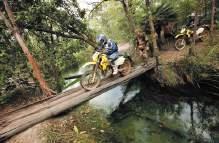







Sitting at an altitude of just over 3000m, Song Köl is the largest body of fresh water in Kyrgyzstan. Our yurt camp sat lakeside and our arrival was met with soft cheese, hard crackers and smooth red wine. Sunset over the lake was spectacular. When the sun dropped behind the clouds the lake itself changed colour and wild horses ran across the plain as the sun finally dipped behind the horizon.
Later in the evening the hosts lit a bonfire and stories were told as riders bonded over shots of vodka and the mechanic’s home brew from a distillation of 27 plants.
Retiring to the yurts for the evening everyone was pleased to discover the
wood-burning stoves had been lit, making the accommodation warm and inviting.
Leaving Song Köl allowed a stop on top of a 3460m pass giving incredible views into the valley below. Winter snow still sat beside the road and some carved messages into the ice and took photos. Others engaged in a snowball fight.
Leaving the mountains meant the ride was all about the lakes.
We reached the shores of Issyk Kul, the second-largest alpine body of water in the world. The name means ‘warm lake’, so even though it’s surrounded by snowy peaks, it never freezes. Inflatable rings,

beach umbrellas and children splashing in the water replaced the yurt camps and alpine peaks of the previous week.
The next day was spent off the bikes but the adventure didn’t stop.
Early in the morning two former Russian army trucks transported everyone to the alpine valley of Altyn Arashan. It’s only a 14km trip, but it takes over two hours due to the steep and rocky terrain. The trucks bounced over enormous boulders while hugging a path with steep drops to a raging, freezing river below.
Once at the evening’s yurt camp, some chose to hike the surrounding hills while others indulged in the more relaxing option of a soak in the hot springs to ease muscles still twitching from the truck trip.
A rainbow emanated from the mountains of the Chinese border and thunder reverberated down the valley, but the yurts kept everyone warm and dry.
An ascent of the Jeti-Orghuz canyon kicked off the next morning.
Above: The scenery had already delivered in spades, but the next day it went up notch.
Left: A fantastic panorama of 14 motorcycles, strung out like beads on a string, twisting up the rocky path.
Above right: Overlooking green summer pastures surrounded by snow-capped peaks.
Right: The bikes were parked in front of The Seven Bulls, an outstanding natural rock formation.
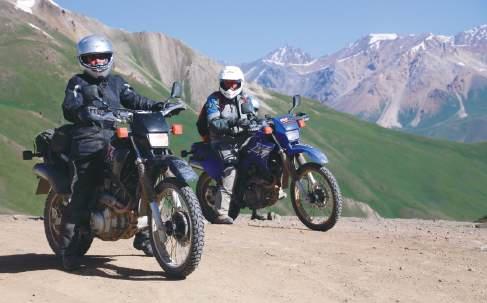
The bikes were parked in front of The Seven Bulls, an outstanding natural rock formation. Most could only count five bulls, but who wants to be a critic in such a beautiful location?
The highlight of the day was an eagle-hunting display from Nursaltan, a 21-year-old, third-generation eagle wrangler. The display was much more than just a show for the tourists. It was a genuine link to the days of Ghengis Khan, founder of the Mongol Empire, where the practice of eagle hunting is thought to have originated.
Nursaltan first made sure a rider donned a heavy-duty glove, then placed the eagle on the rider’s arm. The eagle was heavy, huge, and looked even bigger when it spread its wings.
After capturing the moment on cameras and iPhones, the eagle was released to seek and pounce on an old fox skin. It was all very dramatic and quite harmless. But then, a live rabbit was placed on the ground and jumped about as the eagle lined him up from a great height and swooped.
He dropped on the unsuspecting animal, spread his wings and sat patiently until the young handler arrived, disentangled the rabbit from the talons, and allowed it to hop away, albeit a bit nervously. No animals were hurt in the demonstration.
The following morning was spent riding along the shore of Issyk Kul, winding slowly to the capital Bishkek, where the Compass crew prepared lunch while the group wandered through petroglyphs dating from 1500BC.
After a leisurely lunch and another afternoon of gorgeous, scenic riding, the group wound up at the Oson Hotel in an impossibly beautiful location, deep in the Chychkan u


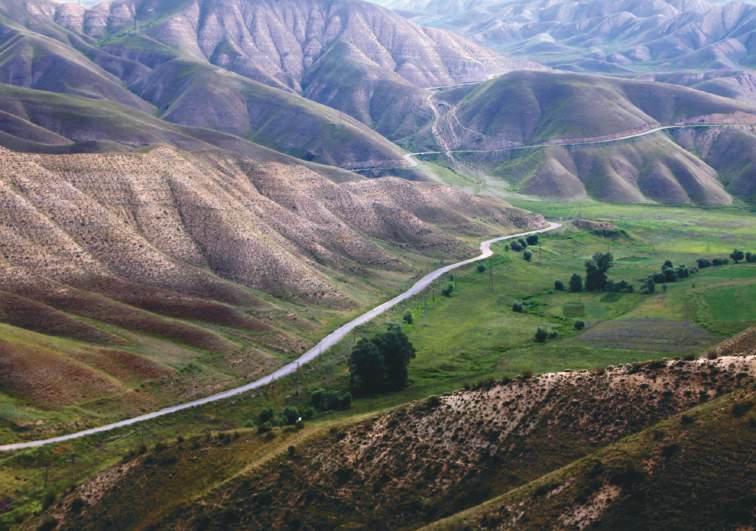
Gorge alongside the glacier-fed roaring Chychkan River. But it was the Compass group that proved to be the tourist attraction. An enthusiastic group of locals snapped photos of the bikes and riders, and it was a common reaction everywhere when 14 motorcycles arrived in any village.
This country has yet to be touched by mainstream tourism.
Human resource
The penultimate day meant riding the shores of Toktogul Lake and the banks of the mighty Naryn River through a barren
landscape of red-walled canyons and valleys. It was yet again completely different landscape to everything experienced so far.
A descent into the Ferghana Valley and ride alongside the Uzbek border fence saw the group running the gauntlet of corrupt police with well-hidden speed cameras before climbing to the cooler temperatures of Arslanbob. This almost totally Uzbek-populated village is home to the world’s last remaining relic walnut grove.
The final home stay was a rare delight, including a meal shared with the Uzbek hosts and a night spent in their home before a trip to the walnut grove.
Everyone climbed into ancient Russianbuilt UAZ 4X4s and bumped and ground up the stony path to the grove, then walked to a panoramic point overlooking the valley and the soaring mountains.
Later was a visit to some waterfalls where the locals gathered under the spray to cool down on hot mornings. The path to the falls was lined with the stalls and attractions of a local market and fair. Colourful jewellery, water pistols, and fruit were all offered for sale, or strength could be tested on a punching bag, darts thrown at balloons, or a rope ladder climbed.
It was amazing to finish the trip with a true local experience. Although the mountains and valleys were spectacular, the true beauty of this country was in its people. At first glance they seemed quiet and reserved, but they soon revealed themselves to be colourful and hospitable. They’re proud of their country, and rightfully so.
The trip finished with a ride back into Osh in the late afternoon of the 14th day. The ride exceeded expectations both in terms of natural beauty and the hospitality and variety of the people.
In a world where Lonely Planet has a guidebook for every location except Kyrgyzstan, this country remains wild, rugged and undiscovered. It’s an epic destination in every sense of the word. Its mountains, switchbacks and people offer the kind of adventure that can be best experienced and enjoyed on a bike. Riders should grab the opportunity to enjoy Kyrgyzstan while it’s still in its rugged and untainted state. kyRgyzsTan

Above: This country has yet to be touched by mainstream tourism.
Below: Leaving the mountains meant the ride was all about the lakes.


Details about the Compass Expeditions’ Kyrgyzstan Explorer tour can be found at: http://www.compassexpeditions.com/tours/kyrgyzstan-explorer/

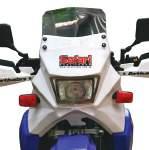




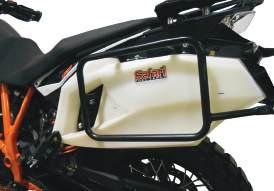

aimed at having us all think about ourselves and our riding.
Back in early ‘naughties’ dualsport riding came along and I embraced it. I was sick of watching my speedo more than the road. The best bits of blacktop had between five kilometres and 50km of dirt joining them up which needed to be dealt with and were usually deserted. Great campsites were often at the end of a dusty road and on a trip to Tassie in the 1990s I vowed never again to be in a position not to go have a gecko. Aussie roads had deteriorated to
sealed goat tracks and didn’t look like getting any better. A bike with plenty of suspension travel made quick work of them and I was ready to make a change.
I hesitate to call this gig a sport. It’s so much more. One doesn’t refer to ‘a bit of horizontal folk dancing’ as sport. Like breathing, sleeping and eating, these are essential activities. Riding a bike occupies a niche in there somewhere, and it’s a whole lot more than a sport.
But what has adventure riding
evolved into and where is it going? Before I start putting the tyre before the rim lock, maybe the best question to start with is, what is it?
Adventure and motorcycles have always been best mates. Is that enough? Does adventure riding have to include dirt roads? Does it need a special type of bike? Is luggage required to distance it from a trail ride? Is a big bike the go? Should the bike have special
tyres fitted? Do we have to cross rivers, scale snotty hills or career about in sand to have an adventure on a motorcycle? Can you take a pillion?
Obviously, adventure riding can include all of these and more.
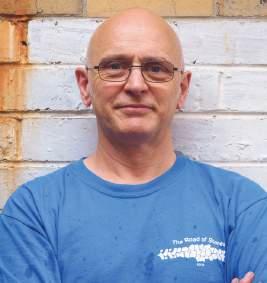
On a recent trip, Mrs Strapz had a massive adventure aboard her ’76 T3 Guzzi. She rode more dirt roads than she has in ages and thoroughly enjoyed it. Just ’cos she’s on an old clunker of a road bike, does that mean it doesn’t count?
Those of you who’ve had the pleasure of the TTT Rally may not know that it originally was a run-what-ya-brung event and participants were expected to ride in on road bikes. Big roadies and sidecar outfits struggled in on deplorable muddy roads, dusted with snow, and it was a serious adventure. By hook or by crook, I tried to take a different bike in for the first 10 years
Left: The author is skilled at wringing out socks on riverbanks. Right: Andy owns one of Australia’s premier motorcycling retailers and accessory manufacturers.



Vince Strang Motorcycles is the place for all DR650 advice and gear-up parts. That’s why VSM is also the best place to buy your fully prepped adventure DR650. We have the experience and knowledge and we have the catalogue of parts. Ride in with a stock DR, ride away totally fitted-out. Discuss requirements with Vince and VSM will supply your built-to-spec DR. Station bike, city commuter or full-blown acrossAustralia adventure bike, get the lot – or anything in between – at VSM. Shop ONLINE for our huge range of DR650 parts and accessories www.vsm.net.au
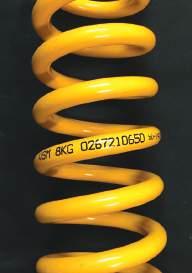

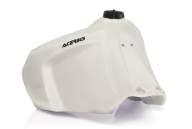

1977
and almost succeeded. A Harley, CX650, 750/4 and the mighty MZ ETZ250 are the jiggers I can remember.
Each to his own
The point is it means something different to all of us.
Some like the challenge of the worst possible road conditions, others want a quiet spin away from the jostling on the main roads. I often feel a little intimidated by riders who grew up on dirt bikes and possess the muscle memory to make big bikes dance in the dirt. There seems to be a testosterone-fed, ‘mine’s-bigger-thanyours’ elitism creeping into the adventure-riding world.
I was once told, “It’s not adventure riding unless you’re doing water crossings”. This magazine’s esteamed (pun intended) editor knows just how skilled I am at wringing out socks on riverbanks. Sometimes a gentle shove outside the comfort zone is fun, but at other times being pushed too hard deteriorates into plain, freckle-puckering, grunt work and it feels the sooner it’s over the better.
My mate Scrawn yarns of taking an entire day to battle through 150km of mud somewhere out in the boonies. Falling every few kilometres, covered head-to-toe in red crud, aching in every joint and sweating like a pig is funny… now. He wasn’t laughing much while it was happening.
Below: The TTT Rally was a run-what-ya-brung event. Access was via deplorable muddy roads, dusted with snow, and it was a serious adventure. Most attended on big bikes.
Right: A bike with plenty of suspension travel makes good sense for Australian conditions.


The old adage ‘an easy road bears no good stories’ – okay, I just made that up – is a truism. On a recent High Country ride Scrawn and another mate, The Bandit, led me into some seriously steep and rough country. Ring-over-taillight descents, boiling brakes, launching over step-ups and tough and rocky up-hills had this intrepid adventurer puffing and wheezing up his toenails. A couple of flat tyres and a very late return to the shed sealed that two-dayer into a solid campfire yarn… once it was all over.
We’re all aging and our reaction times are getting doughy. Getting ambitions and abilities out of alignment takes a lot longer to recover from. Trying to ‘play
with the big kids’ has a distinct waft of Dettol and plaster these days.
Not all adventure riding needs to be tough and not all road rides are unadventurous. Getting filthy is not a measure of success. Fear and apprehension should be reserved for the return home having bought a swag of new bits for the bike, and drifting both wheels on any surface is not a prerequisite to a big grin. There are no second-class citizens in our pursuit. All that’s required is a smile on the melon and a road beneath two wheels. That’s living. That’s adventure enough isn’t it?
Has Andy got it right? Or is he way off the mark? Let us know. Email tom@maynemedia.com.au and we’ll make sure Andy hears your thoughts.

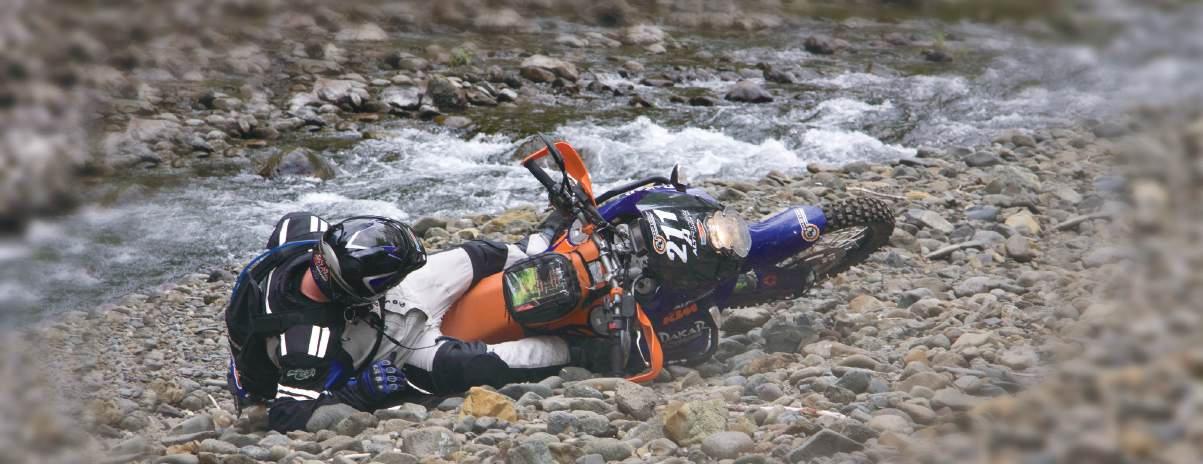



The

recent BMW
GS Safari to Cape York was for some a life-changing experience. Miles Davis was there (for the second half).
The BMW Safari last went to The Tip in 2006, so it’s been a while between drinks. I was in Germany attending a BMW Instructor certification course and missed the first few days of this one, but joined the group in Bamaga for the run south back to Cairns.
There are few destinations in this adventure-riding land that conjure up more wonder than Cape York.
In August this year the BMW GS Safari Enduro embarked on a seven-day journey from Cairns to The Tip return, experiencing everything The Cape had to offer. For some it was a fun, scenic ride. For others it was probably the hardest ride they’d ever taken on.
This year 130 riders gathered in Cairns for the mandatory welcome function, sign on, riders’ briefing and to get to know each other. Early the next morning it was on!
I missed the northward run, but just to put everyone in the picture, the first day ran 438km from Cairns to Koolburra Station, the second 311km to Archer River, and the third 414km to the far-northern village of Bamaga, the nearest airstrip and township to Cape York itself. These first three days included parts of the famous (or infamous)
Old Telegraph Track with its deep sand and some serious water crossings. Everyone was tested, including the BMW Safari tech support team who were on hand to get some drowned bikes back on the road. The sandy conditions took their toll and a couple of riders DNFed with minor injuries.
Some riders sampled the delights of Fruit Bat Falls, an incredible oasis in the middle of a dry and harsh environment, before crossing the Jardine ferry and the final stretch to Punsand Bay Resort for pizza night. Punsand Bay is a small resort right on the beach, between Bamaga and The Tip.
After a 40-hour mission from Germany, I arrived at Bamaga ‘International’ at about 4:00pm. I was stoked, if not a bit surprised, all my flights had lined up and I was actually there in time for the fourth day and the ride back.



I don’t think Punsand Bay had changed much in the 11 years since my first visit. There were lots smiling faces kicking back around the outdoor bar area, while metres away a tiny chopper was flat out taking riders for scenic flights over the The Cape. Earlier, the day had kicked off with a ride to The Tip and a short hike to the ‘You Are Standing At The Most Northern Point…’ sign for the mandatory group photo. It might only be a basic, rocky headland, but for
Main: In August this year the BMW GS Safari Enduro embarked on a seven-day journey from Cairns to The Tip and back.
Above: The day had kicked off with a ride to The Tip and a short hike to the ‘You Are Standing At The Most Northern Point…’ sign for the mandatory group photo.
Right: From Munich in Germany to Cape York in far north Queensland. It’s all in a day’s work for the author.
many it’s a very special feeling to be standing on the very tip of The Cape.
I was reunited with my ‘Finke edition’ 1200 GS Rallye X. One of the journos had ridden it on the first three days and jetted out of Bamaga on the flying cigar I’d arrived on. The bike was still crusty with the distinctive orangetinted grime from Finke and the Simpson, now with a darker red layer from the harsh FNQ conditions. u


I slipped back into Safari mode with the riders’ briefing, then had a great meal and caught up with the crew and customers.
Bamaga to Coen: 487km
It was a bit surreal. Two days earlier I’d been riding at the BMW Off Road facility, a 120-hectare quarry close to Munich. Now I was leaving Bamaga on a dusty, red dirt road. I took a quick spin on the challenging, sandy shortcut track to The Tip and then headed south back to Bamaga and the Jardine River ferry.
The next stop was Fruit Bat Falls, and it was off with the gear down to jocks for a dip and a bit of a massage under the waterfall. It was very refreshing. I teamed up with my good mate Benno, the BMW Tech support rider who fixes flats, bent

bikes and tries to keep everyone on the road. We rode together to the Bramwell Station Roadhouse for fuel and on to Bramwell Station itself where lunch had been arranged.
The road south was pretty fast at times, but dusty with some nasty, rocky sections. Unfortunately one of the guys hit a G-out way too fast on his 1150 GS and bottomed it out, causing some damage to the sump. He had to sit on the side of the track and wait for the support vehicle.
A few kilometres down the road I was surprised to see a boat on a trailer on the side of the road. The trailer had no wheels. It was a large tinny with a big outboard and one wheel had selfdestructed. The alloy rim was gone and it was turning on the hub and a few

stubby alloy spokes. The other wheel had snapped off at the hub. It would’ve been an expensive hassle to get that set up recovered, and it just shows how tough these conditions can be on vehicles.
A bit further on the road turned to tar and we rolled into the town of Coen. The pub put on some great food, and not long after I felt like a jet-lagged zombie so I hit the sack for some much needed rest.
Coen to Cooktown: 387 km
After brekky we headed off for another day of FNQ adventure.
Some classic, red, Cape roads brought us to the fuelling stop of Archer River Roadhouse. Again dust was something you had to manage: don’t just sit in it. Either pass or take a break, whichever suits you best.
The terrain and scenery were magnificent with some twisty sections that were a blast, rolling on the power on the big boxer-twin and steering with the throttle. You never get sick of that!
I could smell the salty ocean in the distance as we came into Cooktown, a stark contrast to the dry, dusty conditions of the day. I encouraged riders to take the short, twisty spin to the lighthouse lookout which gave an amazing view of the town, the river and the vast ocean. It’s always an impressive sight.
Left: For some it was a fun, scenic ride.
Below left: Some serious water crossings.
Below: You never get sick of steering with the throttle.
Right: Cooling off at Fruit Bat Falls.
Below right: For some it was probably the hardest ride they’d ever taken on.
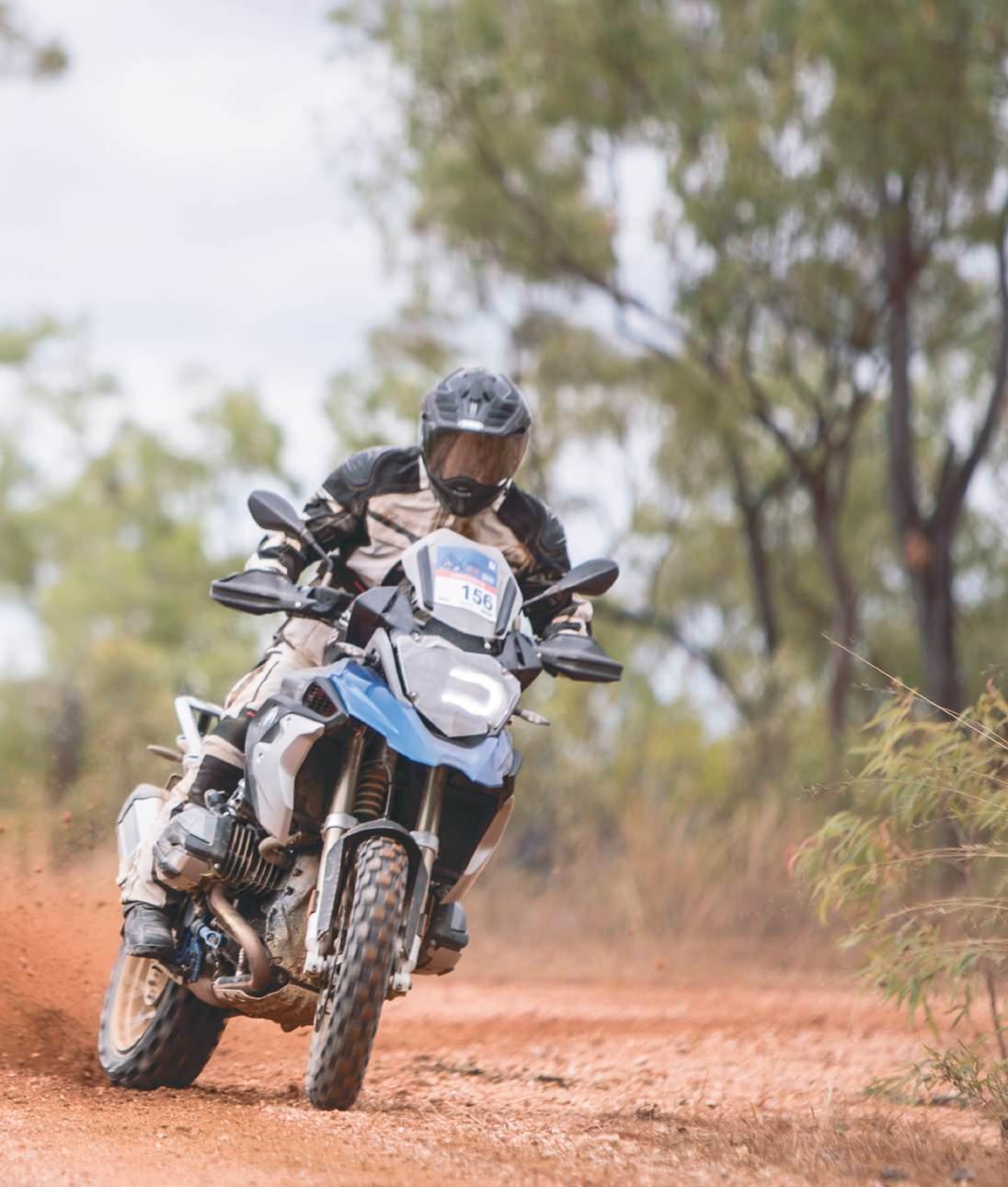

Staying at a flash hotel that night meant many riders spent the evening in the pool ordering drinks, having plenty of laughs and recounting the day.
The last day of a Safari always has a tinge of sadness to it, and it’s amazing how quickly it comes around. But that just means you have to make the most of it!
The route had us heading out of town past the Lion’s Den Hotel and into croc country along the Bloomfield River. Heading south from there the road became narrow, steep and twisty in places and there was a lot more tourist traffic as we approached Cape Tribulation. There are a few creek crossings along this section but most were fairly dry at that time of year.
It was a buzz rolling into the ritzy Palm Cove resort with another adventure over and, as usual, there was a real high among the Safari team.
The farewell function is where it’s not uncommon to let your hair down. Unfortunately for me, my travels took their toll and I went to bed when many went out and got a bit crazy.
Next year, 2018, will be a big year, kicking off with the GS Safari High Country in March.
Bring it on!







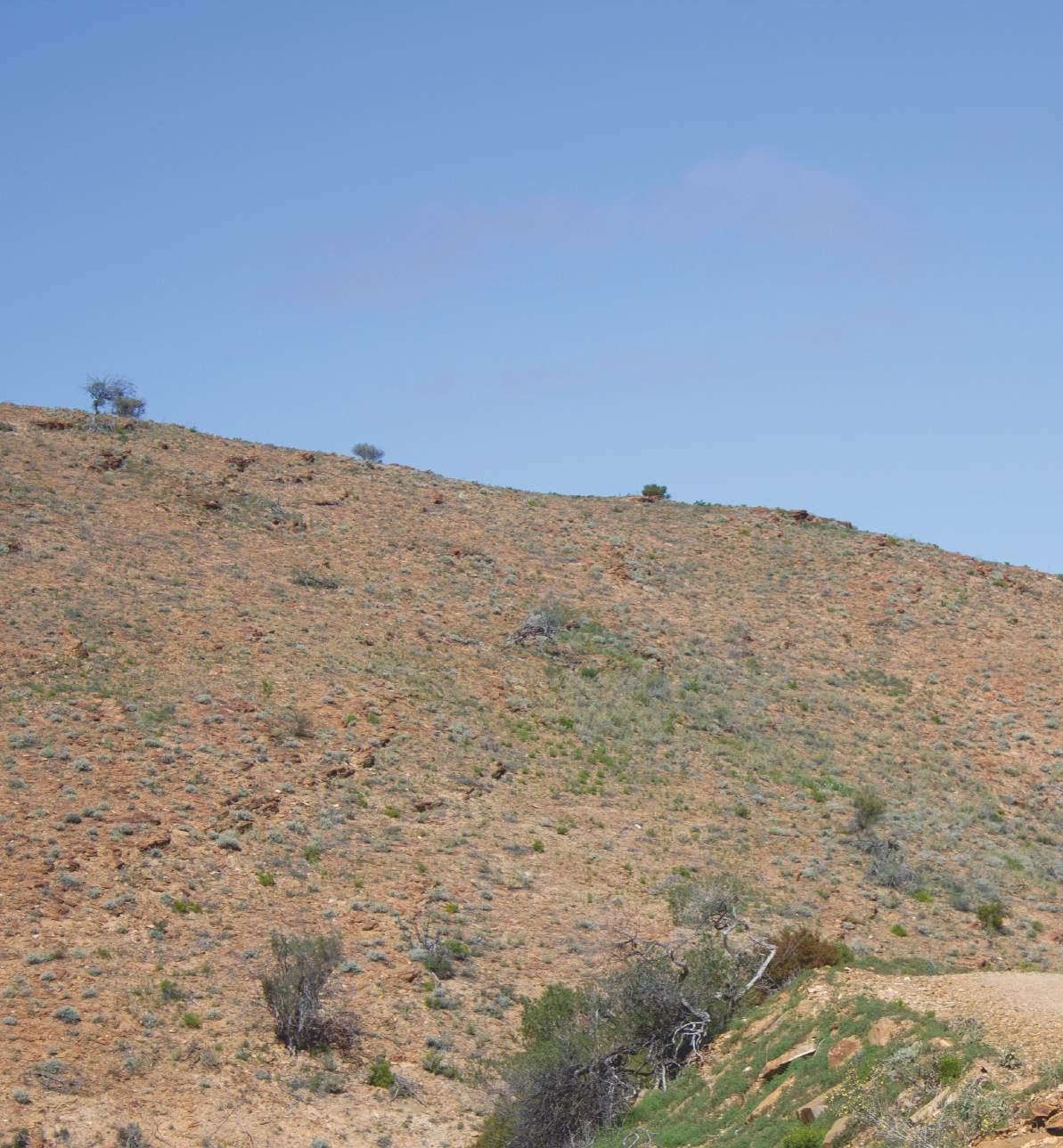



Log on to




Thousands of kilometres of premium dualsport and adventure riding on route sheet and as GPX files. Complete with fuel and accommodation contacts and info, route section times, stories and heaps more.


Serious hard-core adventure riding at its best, all captured on camera and crafted into 20 DVDs.
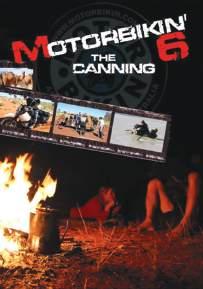

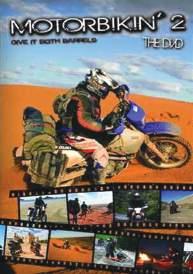
The ultimate adventure-riding distress beacon that should be part of every adventure rider’s kit. Provides six independent means of rescue:
406MHZ transmission
121.5 MHZ homing signal
GPS location
Visual strobe
Signal mirror
Whistle on lanyard Manufactured in Australia. 10-year battery life. 10-year warranty. t

Karen Ramsay is handy at reading a map, but she found plotting a route was a whole other kettle of fish.
Words: Karen Ramsay


It seemed simple enough: organise a surprise weekend riding for hubby Dave’s birthday.
Armed with Google Maps and the idea of trying to include some tracks he likes to ride on his birthday each year, I thought it’d be easy to plan a special couple of days.
That was my first mistake.
A map just looks like a whole lot of squiggly lines. There’s so many roads and tracks and trails out there. How do you know where to begin? Or to quote a C.W. McCall song, the roads looked like ‘a whole bunch a Zs and Ws’. I had no idea which ones were easy and which ones needed the skills of a super enduro rider to conquer.
When I’m riding places I’ve been before, it’s familiar and I can find my way around – or at least have a pretty fair idea of where I’m going. But trying to plan a route from a map is really difficult without a good knowledge of the tracks you’re planning on taking or being an amazing rider who can ride anywhere.
Dave is known around our way as ‘The Human GPS’. He has an incredible memory not only for the different tracks he’s been on, but also ones he’s heard other people talk about or even ones he’s looked at on maps. Someone only has to mention a place and he can give them half a dozen different routes of varying difficulty to get there and back. He’s managed to put over 150,000km on his BMW F800GS in five years and the majority of that distance was done on weekends away. Occasionally we can get away for a week or more, but it just shows what’s possible when you have the time to get out and about.
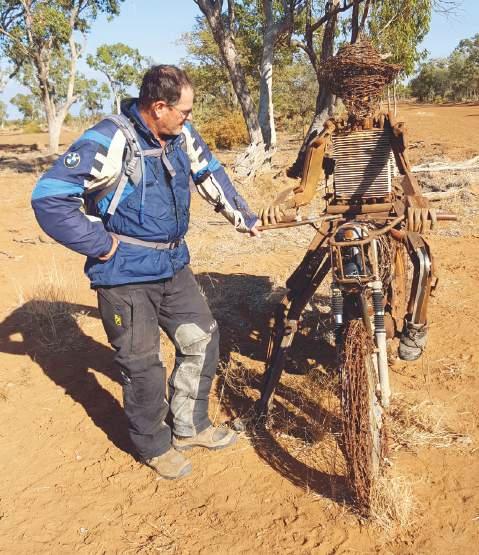
In recent times, quite a few of those kilometres have been added when he’s out doing a recce ride. They usually consist of him taking a day or two off work, or picking a weekend when I’m busy, and exploring the squiggly lines on the map to see which ones are good, which are even better and how he can join them all up. He likes nothing better than sharing this with others and delights in taking people on roads in their own backyards they probably haven’t been on before. Strangely enough, we don’t have a GPS. When you’re married to one, there’s no real need for an electronic version – although he’d beg to differ with me if we’re trying to
navigate in the city and have to pull over every few blocks to look at a map. Or when we’ve taken the third wrong turn in a row looking for the track someone told him was ‘just past the crooked tree where the old hay shed burnt down a couple of years back’.
When it came time for us to head off on Friday after work, I knew where I was headed but had no clear idea on how to get there. I gave Dave a couple of vague hints on where we were going and he instantly gave me a number of different routes of varying lengths and times to get us in the general southerly direction I was planning,
even though I didn’t tell him exactly where we were going. We headed off in the stinking heat, rode the edge of a storm, had a swim and watched the tempest roll in. Dave ended up having a great weekend, despite the fact he chose most – okay, all – the routes. Even better, it included some of the ones I really wanted to include but didn’t know how to join up.
Unfortunately, my lacklustre route-planning skills are matched by my bike awareness. Just recently I rode nearly 60km, blissfully unaware I had a deflating back tyre. Something felt a bit odd, but the front tyre looked fine as I rode along so I thought I was imagining things. It wasn’t until we got home we discovered the flat. Then, next time I rode after fixing the tyre, I never thought to pump the rear brake pedal. I found I had
no rear brake initially as I rode down the driveway. These sorts of things make me wonder if these are things I can learn or if it’s innate.
It’s not just me who appreciates Dave’s route-planning skills. A whole bunch of tough-asthey-come adventure riders recently put their hearts on their sleeves and let Dave know how much they valued his expertise too. Their kind words and readiness to show Dave their affection for what he does to share his passion for adventure riding and his love of the bush rendered him temporarily speechless. It was a wonderful thing – as long as he knows this doesn’t mean he has a free ticket to skive off at any time to go for a recce ride. There’s a few jobs need doing around the house.

R Being a passive rider doesn’t improve navigation skills
R I need to add a basic mechanics course to my to-do list
R Plotting a route is hard
R Stop the bike to check tyre pressure
R Having a human GPS for a husband offers endless route possibilities

Top case from $590
Pillion seat bag from $305
Tank Bags from $92
Comfort seat from $672
Pannier systems from $1830
Suspension from $1699
Footpegs from $260
Engine crash bars from $370
The best of German engineering and craftsmanship on Honda’s flagship adventurer.
GPS handlebar bracket from $92
’Bar risers from $103
Windscreen from $262

Headlight protector from $162
Crash bars from $611
Auxiliary headlights from $785
Headlight protector for LED auxiliary headlight from $89

Sidestand extension from $69
Engine guard from $566
Warp 9 adventure footpegs.
Top-of-the line adventure ’pegs from the USA.
R Available for DR650, DRZ400 and KLR650
R A full 125mm long and 62mm wide
R Ceracote-coated Chromoly steel pivot
R Replaceable 7075 T6 aluminium platform
R Permanent stainless teeth
R Available in three colours
R Built-in bottle opener in the bottom
RRP: $299
Available from: Adventure Bike Australia
Web: adventurebikeaustralia.com.au
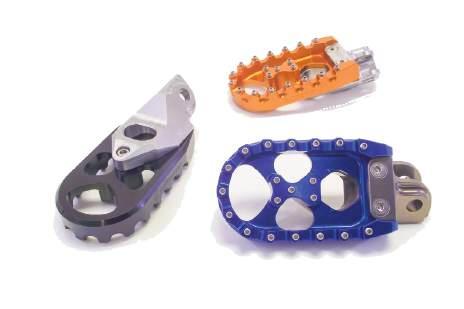
Mastech crash bars for suzuki
dL650 vstroM ’04-’15
Get that ’Strom behind bars.
R Strong, 25mm carbon steel
R Stylish construction
R Easy fitment
R Fits with B&B bashplate
RRP: $245
Available from: Adventure Motorcycle Equipment
Phone: 1300 883908
Web: adventuremotorcycle.com.au

heLd desert g
A light summer glove.
R Abrasion-resistant kangaroo leather palm
R Mesh fabric (100-per-cent polyester), leather detailed back
R Colour-fast and sweat-proof
R Velcro adjustment at cuffs
R Elasticated leather panels on back, thumb and fingers
R Hard-plastic knuckle protection
R Available in black only
R Sizes 6 - 12
RRP: $130
Available from:
airhaWk


All the benefits of an Airhawk, but built right into the seat!
R Ergonomically distributes weight
R Maintains narrow leg passage with comfort
R Sculpted to centre the body in the seat
R Space Mesh material on AirHawk IST
R AirHawk Standard seat is factory stock seat height
R AirHawk Low seat is 1.25 inches lower than standard
R Fits 2013 to present R1200GS and GSA models
R Matching pillions available with Air
RRP: On sale for $700 including free delivery in Australia
Phone: 1300 783 128
Buy online: airhawk.com.au

More power from the DR650 front brake? That has to be good.
R Rotors are laser-cut from a high-carbon content, 410 stainless steel, then lap-cross hatch ground and heat-treated
R Finished rotors are mounted on a floating black steel carrier for durability and strength
R Floating pins are an oversized, CNC-machined stainless rivet with stainless wave washer to ensure rivets won’t crush
R High-temp paint is applied to surfaces like cooling holes and edges to provide a clean, finished look
RRP: $330
Available from: Vince Strang Motorcycles Web: vsm.net.au

Heaps of great features on this riding suit.
Way more than we have room for here.
R Waterproof labyrinth closure system
R SAS-TEC protectors
R Reflective elements for best visibility
R TPR rubber applications
R 76cm long connection zipper
R Stretch panels for best action
R Climate comfort by ventilation system
R 76cm connection zipper
RRP: Jacket $649.95. Pants $399.95
Available from:
Your nearest Ficeda dealer Phone: 1300 437 711
94 advridermag.com.au

Just drop it on the passenger seat and tie it down with its own strap system. No frames or hardware needed.
R High-quality, made to last (like all Andy Strapz gear)
R Constructed of black 600 denier Cordura
R 18-litre capacity
R Stiffened with four nylon bars to stop sagging
R Strap system permanently attached
R Stable, easy to use and very water resistant
RRP: $210 each plus postage
Available from: Andy Strapz Phone: (03) 9786 3445 Web: andystrapz.com

An upscaled version of Helinox’s lightweight camp table.
R Generous 76cm x 57cm surface area
R Height: 50cm
R Capacity: 50kg
R Packed weight: 1.59kg
R Packed length: 60cm
R Five-year warranty
R Folding ‘hard top’ design
Available direct from helinox.com.au for $196 with free delivery Web: www.helinox.com.au
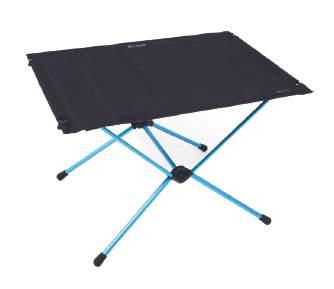

Everyone loves a product that can just fit on their bike with no hassles. Find what fits your bike on the Barkbusters site.
R Barkbusters hardware kits are custom designed for the perfect fit on many street, adventure, dualsport, trail and rally bikes
R Manufactured in Australia, Barkbusters Handguards is a world leader in handguard design and production
R Barkbusters website is also a world leader for responsive, user-friendly layout and easy to find information with clear images of all products
R Go to WWW.BARKBUSTERS.NET to find exactly what fits your bike
Barkbusters available from: Your local bike shop
Web: barkbusters.net
An updated version of the Terra. The addition of the FCS (Flex Control System) provides ankle support and protection without making the boots too rigid.
R Oiled, full-grain leather upper
R FCS external ankle support pivot system
R DRYTEX waterproof and breathable liner
R Adventure dual-density, anti-slip replaceable lug sole
R Integrated mid-sole with stainless-steel shank
R External injection-molded plastic protection
R Adjustable straps with velcro closure
R Optional stainlesssteel toe caps (included)
RRP: $439
Available from:
All Forma dealers in January 2018
Phone: (03) 5792 3888
Web: formaboots.com.au
Change the way you move and store your bike with innovative, 360-degree mobility.
R Tough, durable, multi-directional wheels provide smooth 360-degree movement
R Store your bike in a compact, out-of-the-way space
R Easy access to your bike means more ride time
R Safe, quick and easy single-person operation
R Designed to suit a wide range of bikes, double- and single-sided swingarm versions
R Premium build for a lifetime of rides
R Made in Australia
See the website for prices and to purchase Web: dynamoto.com.au


The most light drawing the least power.

R Bright
R Efficient
R Waterproof
RRP: Light kit with two-piece wiring
harness $600. Single pod $235
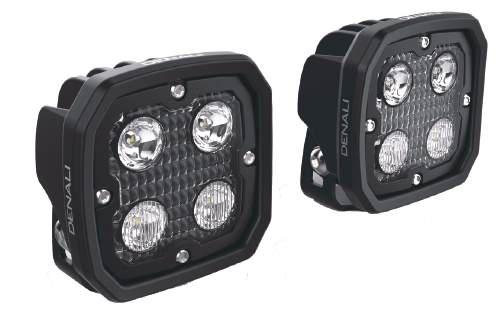
neW sizes of Mitas e07 avaiLabLe
New sizes for a great dualsport tyre.
R Developed specifically for big bikes
R 50/50 design
R New sizes are 120/70B19 front and 170/60B17 rear
RRP: $TBA
Available from: Bike shops everywhere Web: mitas-moto.com


fueL container
A 15-litre, quick-fill fuel container ideal for long-range fuel tanks. Injection-moulded construction
Specially designed and located filling handles
Long extension spout for easy filling
Available in five factory OEM colours
Large graphic side panels customisable for a factory look Made in Italy
RRP: $89.95
Available from: Your local dealer Web: jtr.com.au

green chi
Simple kit to be used by itself or with the Uprising kit or Soft Rack.
R Secure swags, tents, bedrolls or waterproof bags
R Constant-tension straps
R Fits any adventure bike
R Quality webbing material
R Steel buckles
R Hand-made in the USA
outback Motortek
ktM1090 upper crash bars and skid-pLate coMbo
Preserves the low centre of gravity of the KTM 1090.
R Lightweight
R Superior strength from non-floating design
R Five-millimetre-thick skidplate with venting
RRP: Was $770. Now $755
Available from: AdventureMoto Web: adventuremoto.com.au

RRP: $58.97 with free delivery in Australia
Available from: Smart Motorcycle Accessories Web: smartmotorcycleaccessories.com.au




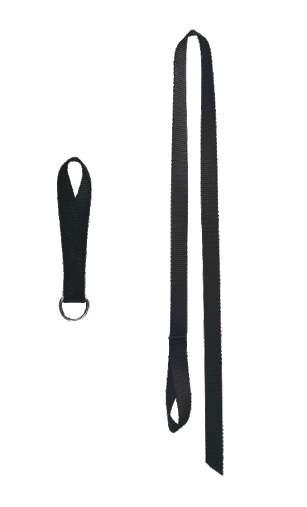



A great Euro-made alternative to your tired OEM BMW shock.
R Top-of-the-range shock
R Fully adjustable spring preload, rebound damping and high- and low-speed compression damping
R Choice of linear or progressive spring
R Optional length adjuster +/- 2.5mm (both front and rear)
R Optional hydraulic preload adjuster (rear only)
R Five-year warranty
R 100-per-cent serviceable
R Engineered and produced in Holland
R Also shock options for the Adventure model
RRP: Front part no. 17.14.12.2617 $1235.
Rear part number 27.14.12.0117 $1235
Available from: Teknik Motorsport Web: teknikmotorsport.com

Keeps glasses, safety glasses, safety goggles, prescription glasses, face shields, masks, visors, sports optics, windows and mirrors free from fog.
R Easy to apply
R Works well
R One application lasts quite a long time
R Around 70 applications from each pen
The Rush jacket is ready for your summer rides.
R Super-tough Durylon and mesh construction
R Safe-Tech CE-approved shoulder and elbow armour
R Pocket for CE back protector
R Oversize pockets for easy phone/ wallet carrying
R Multi-adjustable waist, hips and sleeves
R Two colour options –black or black/grey
R Men’s sizes S – 4XL
R Ladies sizes XS – 2XL
RRP: $229.95
Available from: Selected stockists Web: linkint.com.au

Handcrafted in Bulgaria. Bumot Defender system includes:
R Friction lock hinges
R Made from two-millimetre aluminium
R Stainless-steel, quick-release locking mechanism
R 3M reflective logo decals
R Smooth powder-coat finish
R Available in silver, frozen grey or black

R 100-per-cent waterproof and dustproof
R Anodized and powder-coated steel pannier racks
R Optional tool box and accessories available
R Available in three paired sizes: 35L, 40L and 45L systems
RRP: $1489 per system
Available from: Bumot Australia
Email: info@bumotaustralia.com.au

Protecting your radiator is one of the first aftermarket accessories you should be thinking of.
R Easy-to-install with fitting instructions and video
R Bolts on to an existing mounting point on the bike
R Allows adequate airflow
R Made of high-grade aluminium
R Three-year, worldwide warranty
RRP: $195. On special now for $159
Available from: Rad Guard
Phone: (02) 6658 0060
Web: radguard.com.au

All-season adventure-touring suit.
R Heavy-duty polyester 900D outer shell
R CE-approved armour in knees and backpad
R Removable waterproof and breathable liner
R Reflective printing for low-light visibility
R Jackets available in grey/black
R Pants available in grey/black or black/black (ladies grey/black only)
R Men’s jacket sizes S – 8XL. Pants S – 6XL
R Ladies jacket and pants sizes 8 – 22
RRP: Jacket $499.95. Pants $329.95
Available from: Your local motorcycle dealer
Phone: 1300 300 191


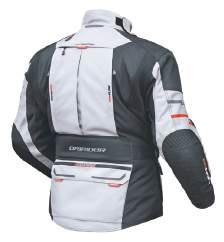

One of the editor’s favourites. It’s a must-have for long-distance rides.
R Simple and effective way to override the return spring of the throttle
R Operated by index finger or thumb
R Thumbscrew allows easy, on-the-move tension adjustment, even while wearing winter gloves
R Can not be overtightened, throttle can be manually closed in emergencies
R Easy use and fitment, can be moved between bikes.
R Low investment point
R CNC Machined 6061 Billet Aluminium – not plastic
R Stainless-steel fittings, will not rust
R Only six millimetres wide
RRP: $63.95 plus postage
Available from: Motorrad Garage
Web: motorradgarage.com.au




Over the past 10 years Motorrad Garage has established itself as one of Australia’s favourite suppliers of aftermarket accessories for road and adventure motorcycles.
Motorrad Garage keeps an extensive range of bike speci c and universal accessories from leading manufacturers such as SW-Motech, RAM, RotoPax and many more in store ready for immediate pick up or delivery anywhere in Australia.
Why not visit the new Sydney showroom centrally located at 53 Parramatta Road, Lidcombe and see what’s available for your ride.
www.motorradgarage.com.au www.facebook.com/motorradgarageaustralia

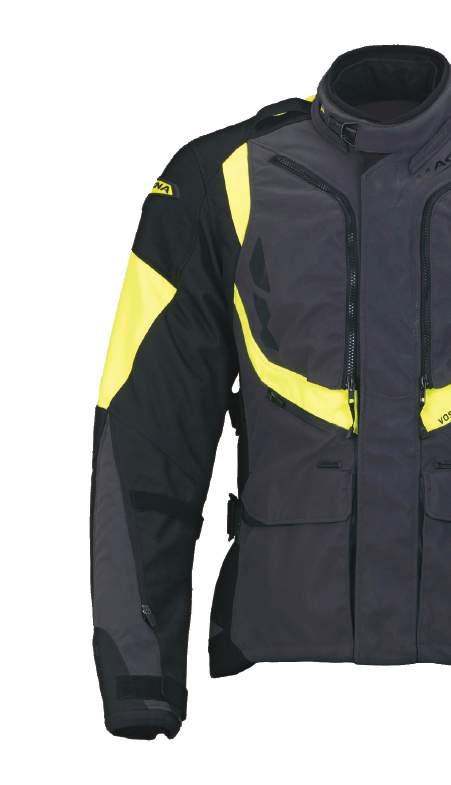
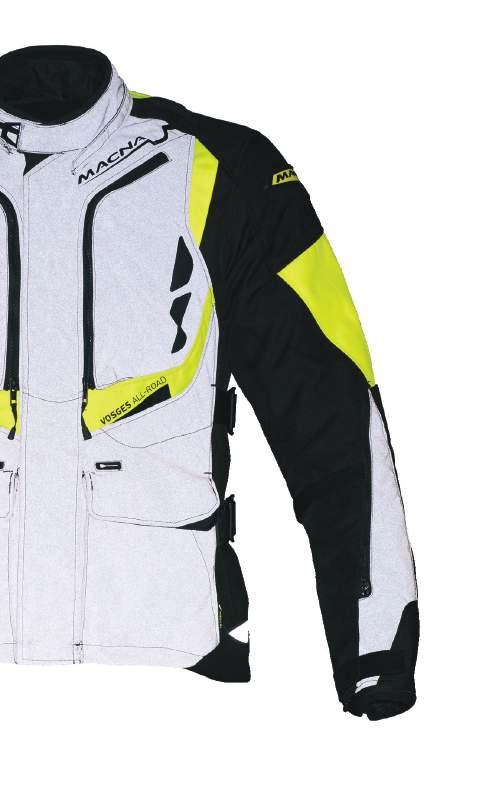
If jackets could have a split personality, they would probably look like this. Common grey by day, incredibly luminous at night; when placed in the range of a car’s headlights, it’ll light up completely!
So how does this radiant fabric work exactly? Basically, it’s coated with lots of tiny beads. They act as satellite dishes, reflecting light back to its source, even from long distances. Just like a road sign! To find out more about the full Macna range and Macna NightEye technology visit www.linkint.com.au


